If you like designing your own clothes or stitching up throw pillows and curtains for your home, but you’re tired of the same old storebought fabric, we’ve got a solution. Why not try dyeing your own fabric with plants?
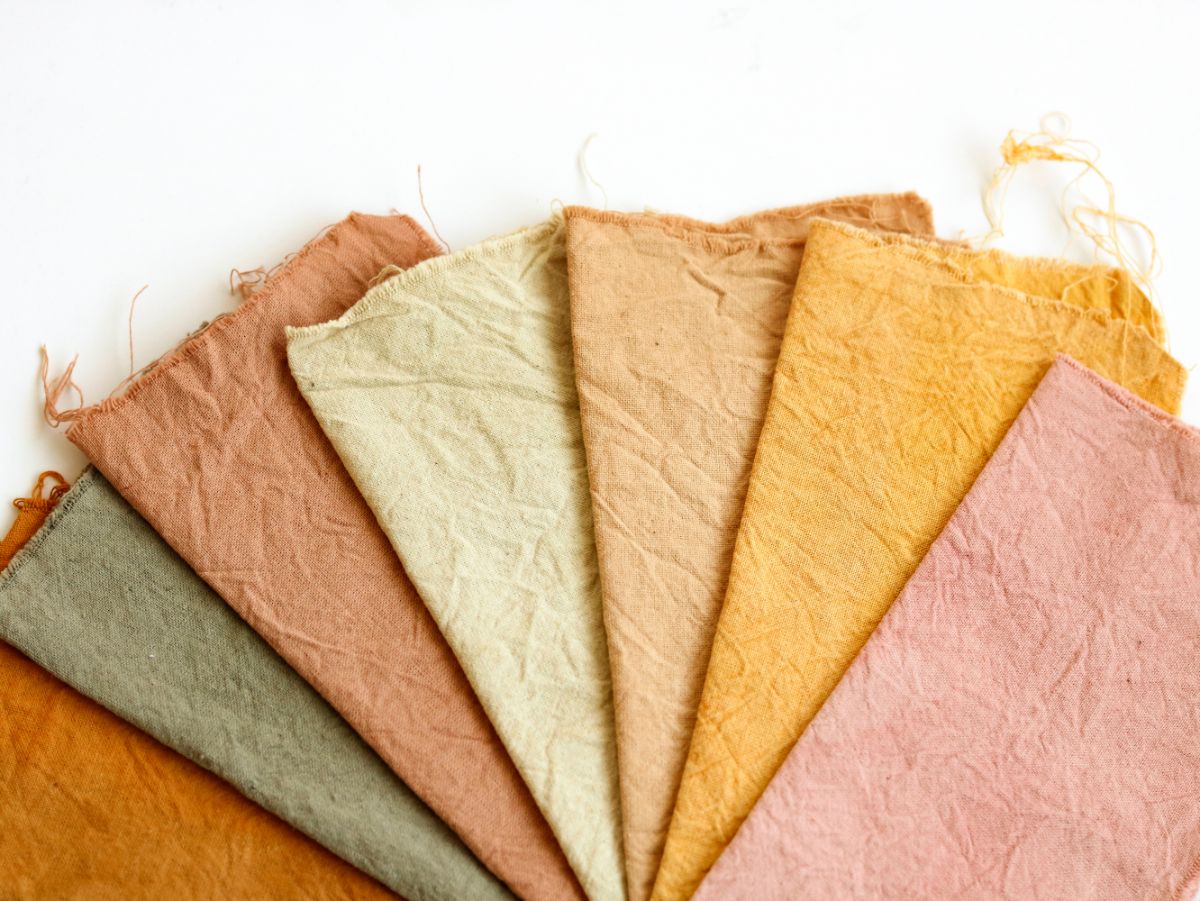
There are actually quite a few plants that make vibrant and colorful all-natural dyes, which are perfectly eco-safe and super easy to make. Check out the following guide for the top plants to grow in your own backyard dye garden for natural dyed fabrics!
Jump to:
- 25 best plants to grow for natural dyes
- Blue plant dyes
- 1. Woad (Isatus tinctoria)
- 2. Bachelor buttons (Centaurea cyanus)
- 3. Japanese indigo (Indigofera tinctoria)
- 4. Russian sage (Perovskia atriplicifolia)
- Yellow and orange plant dyes
- 5. Goldenrod (Solidago spp.)
- 6. Yarrow (Achillea millefolium)
- 7. Dyer’s chamomile (Anthemis tinctoria)
- 8. Black-eyed Susan (Rudbeckia hirta)
- 9. Calendula (Calendula officinalis)
- 10. Bloodroot (Sanguinaria canadensis)
- 11. Dyer’s coreopsis (Coreopsis tinctoria)
- Pink and red plant dyes
- 12. Madder (Rubia tinctorum)
- 13. Hollyhock (Alcea rosea)
- 14. Beets (Beta vulgaris)
- 15. Pokeberry (Phytolacca spp.)
- 16. Dyer’s woodruff (Asperula tinctoria)
- Green plant dyes
- 17. Foxglove (Digitalis purpurea)
- 18. Dandelion (Taraxacum officinale)
- 19. Larkspur (Delphinium spp.)
- 20. Spinach (Spinacea oleracea)
- Brown plant dyes
- 21. Chicory (Cichorium intybus)
- 22. Zinnia (Zinnia elegans)
- 23. Red onions (Allium cepa)
- Purple plant dyes
- 24. Red cabbage (Brassica oleracea)
- 25. Alkanet (Anchusa offinicinalis)
- Frequently asked questions
- Summary
25 best plants to grow for natural dyes
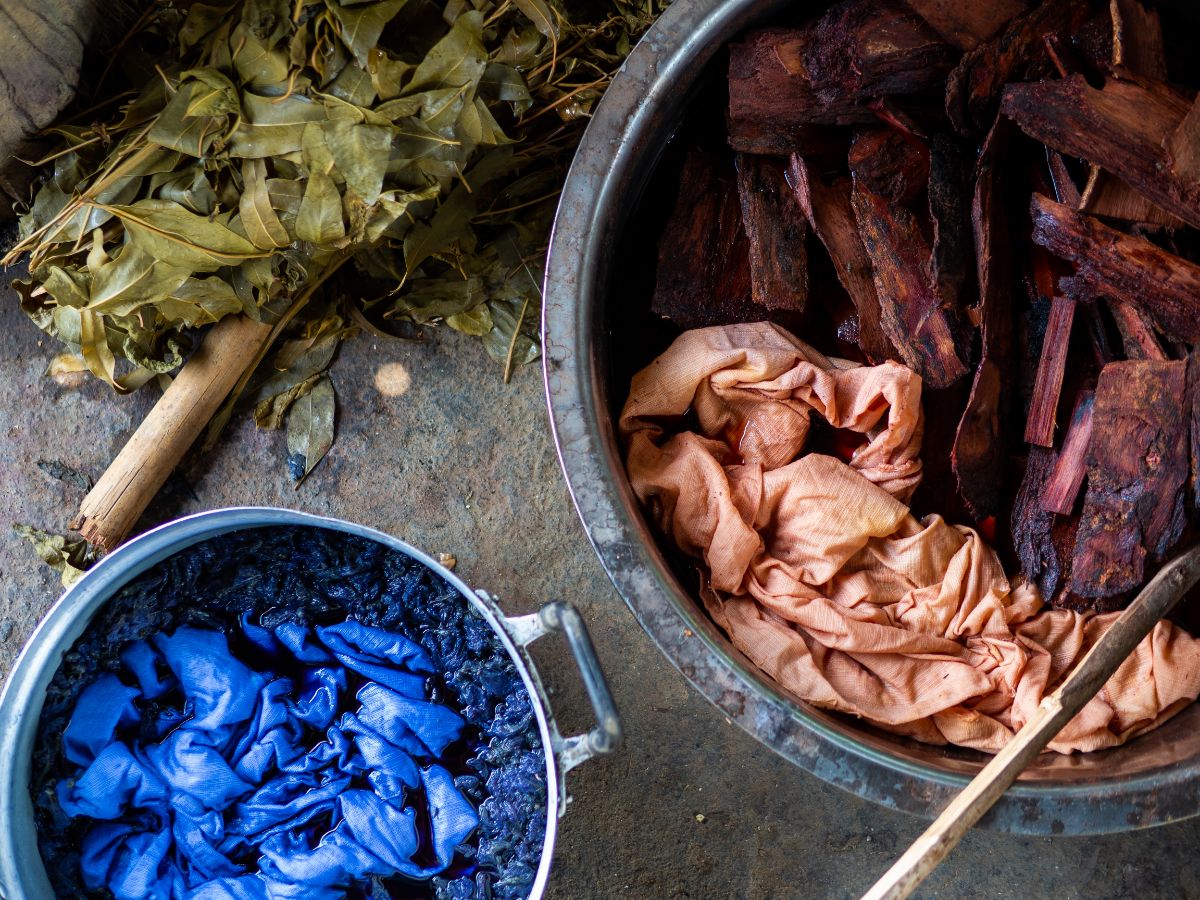
Whether you’re new to eco-dyeing or you’ve been dyeing with natural materials for years, there’s always new colors and textiles to experiment with. Below, we’ve compiled our favorite plants to keep for natural dyes and we’ve even organized them by color so you can find the perfect plant for you.
Most of the plants on this list can be grown in your own backyard with minimal effort. However, some of the plants are native plants that are commonly considered weeds, so you should be able to find them quite easily along roadways, hiking trails and other favorite foraging spots.
Note: If you’re working with wild gathered plants, be sure to follow local foraging guidelines and harvest from areas where you know roadcrews haven’t been spraying pesticides or herbicides.
Blue plant dyes
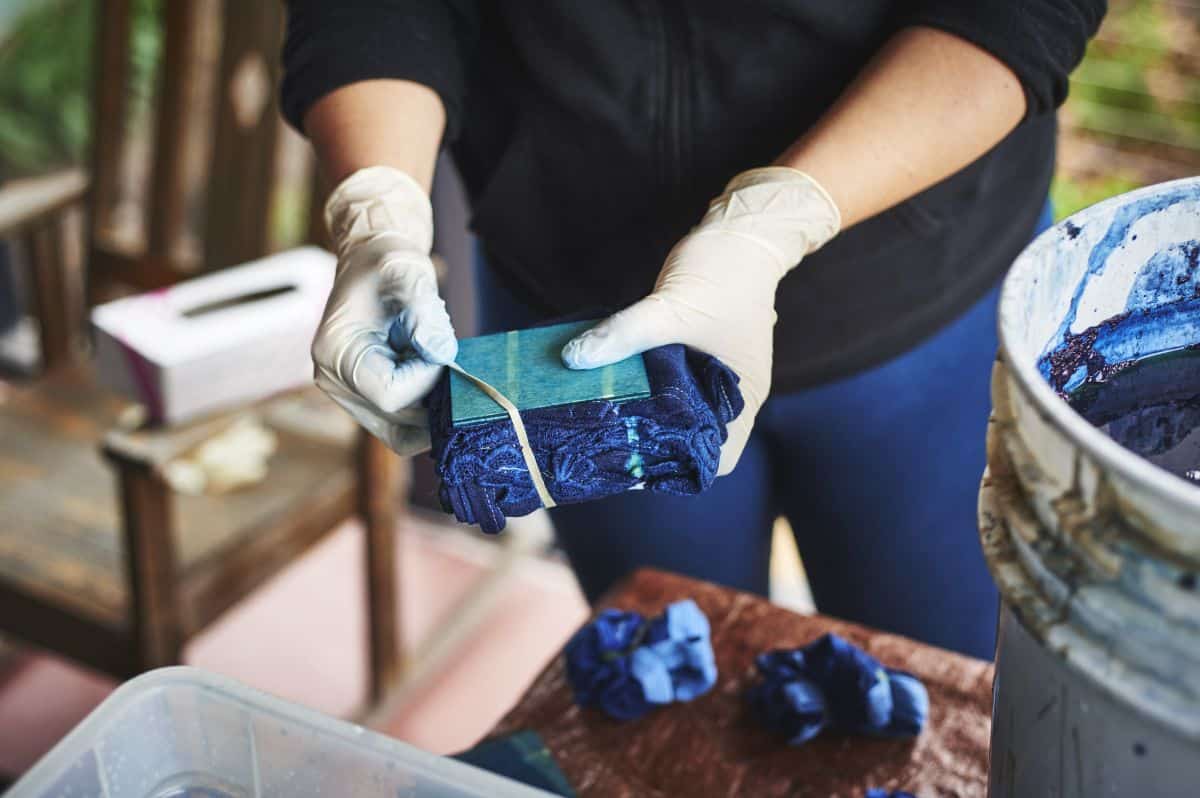
From cornflower blue to deep, rich indigos, there are tons of different blues you can produce from your dye garden. Check out these top plant picks to produce cool blues on wool, cotton and other fabrics.
1. Woad (Isatus tinctoria)

| Plant name: | Woad |
| Color produced: | Blues |
| Plant parts used: | Leaves |
| Recommended mordants: | None |
Woad is a biennial plant in the Brassica family, so it’s related to cauliflower and broccoli! During its second year, woad flowers and then produces an abundance of seeds which it happily self-sows for an endless supply of woad.
A spring-blooming plant with small yellow flowers, it’s actually woad’s leaves that are used for dyeing. Interestingly, woad has been cultivated since the Stone Age and may also have been used to create body paint by the ancient Picts. Today, it is one of the best plants to grow if you want to create homemade blue dye.
2. Bachelor buttons (Centaurea cyanus)
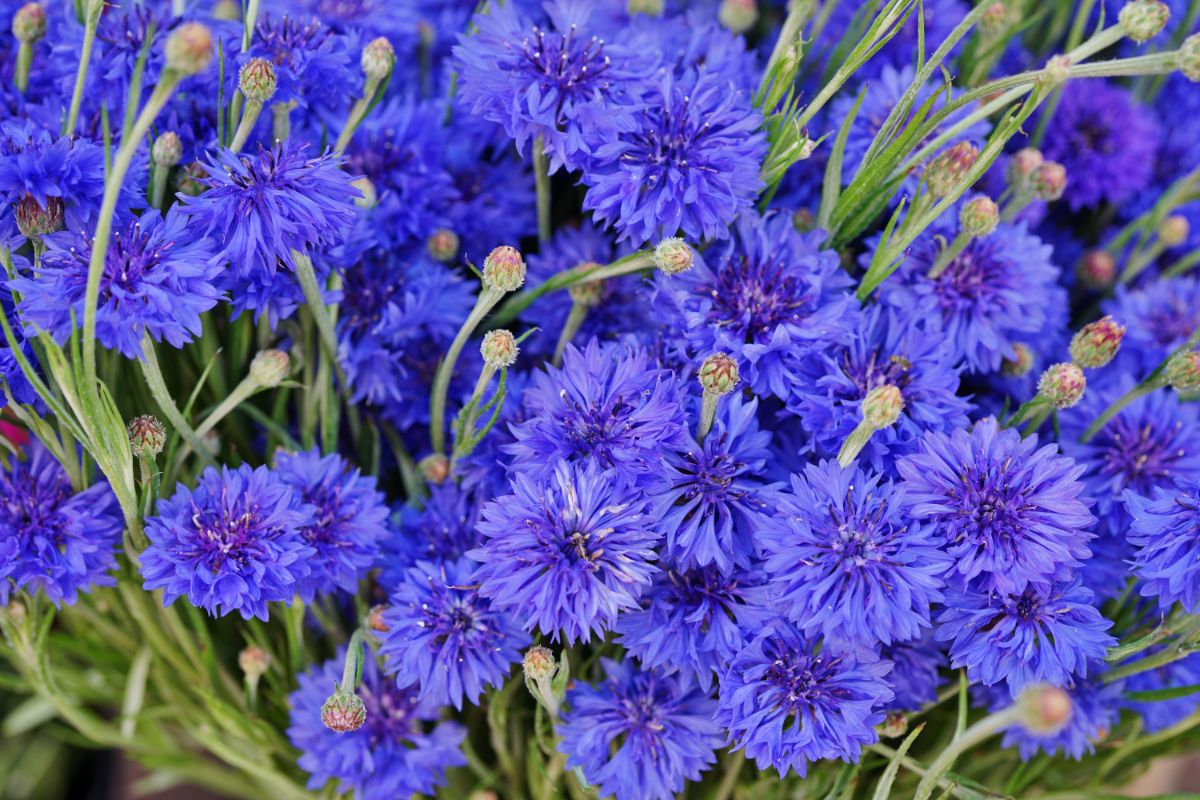
| Plant name: | Bachelor buttons |
| Color produced: | Blues |
| Plant parts used: | Flowers |
| Recommended mordants: | Alum |
Also known as cornflowers, bachelor buttons are synonymous with a bright blue color; however, their globular flowers can also come in pinks and white. A favorite pollinator plant, bachelor buttons are also edible and make gorgeous salad toppers or colorful garnishes for desserts or ice cubes for summertime cocktails.
Bachelor button flowers bloom from spring to fall and are used to create blue tones. Just keep in mind that this plant grows as an annual, so you will need to reseed it every year.
3. Japanese indigo (Indigofera tinctoria)
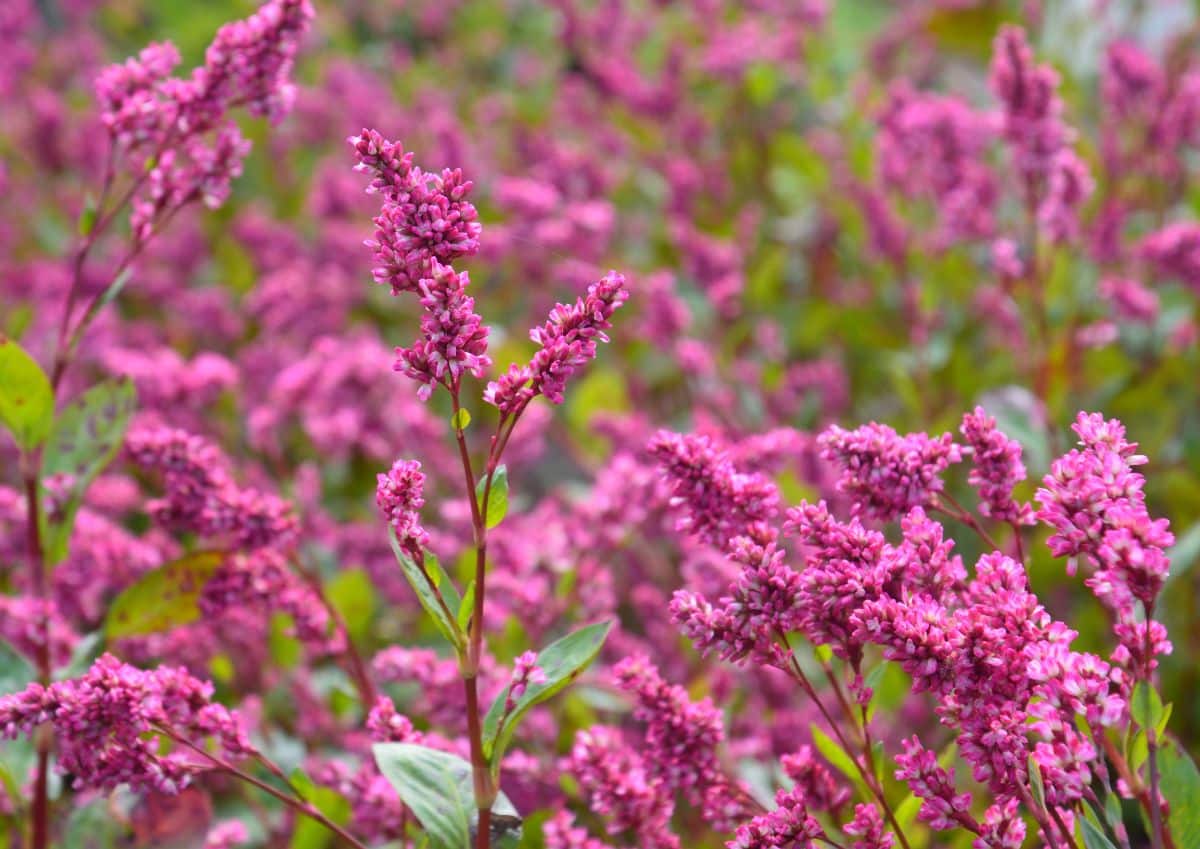
| Plant name: | Japanese indigo |
| Color produced: | Blues |
| Plant parts used: | Leaves |
| Recommended mordants: | None |
One of the most widely known dye plants, Japanese indigo has been cultivated for centuries. Growing as a shrub in warmer areas, indigo is an annual in cooler locations. Feathery leaves add texture to planting arrangements, while flowers are favored for their delicate and airy feel and pink coloration.
Indigo fixes easily to fibers, so mordants are rarely needed. A range of deep blue tones can be produced from the plant’s leaves. Japanese indigo is commonly used with the Shibori method of dyeing.
4. Russian sage (Perovskia atriplicifolia)

| Plant name: | Russian sage |
| Color produced: | Blues |
| Plant parts used: | Flowers |
| Recommended mordants: | None |
A drought-tolerant perennial that’s a real stunner in garden beds, Russian sage looks a bit like lavender, with willowy stems and purple flowers. An excellent pollinator plant that’s popular with bees, Russian sage is sure to add lots of color to your garden… and your dye pots too.
Blooming throughout summer until the frosts of fall, home dyers can use the flowers from this plant to produce a beautiful blue fabric dye. The plant also smells lovely and dries easily for loose leaf teas.
Yellow and orange plant dyes
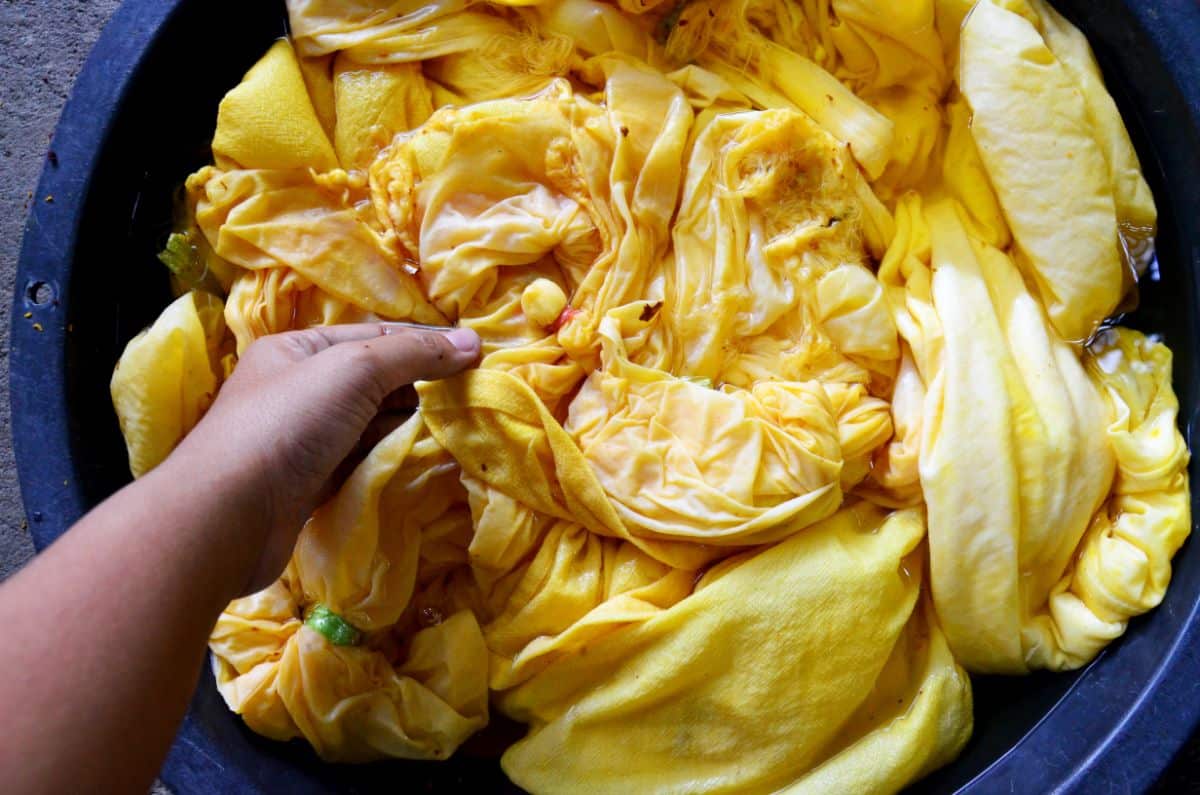
Gold, yellow and orange hues are happy tones that feel like summer when infused into home-dyed fabrics. Some of the best plants to try for yellow and golds are actually common “weeds,” which means you can get loads of material for your dye pot without spending a cent!
5. Goldenrod (Solidago spp.)
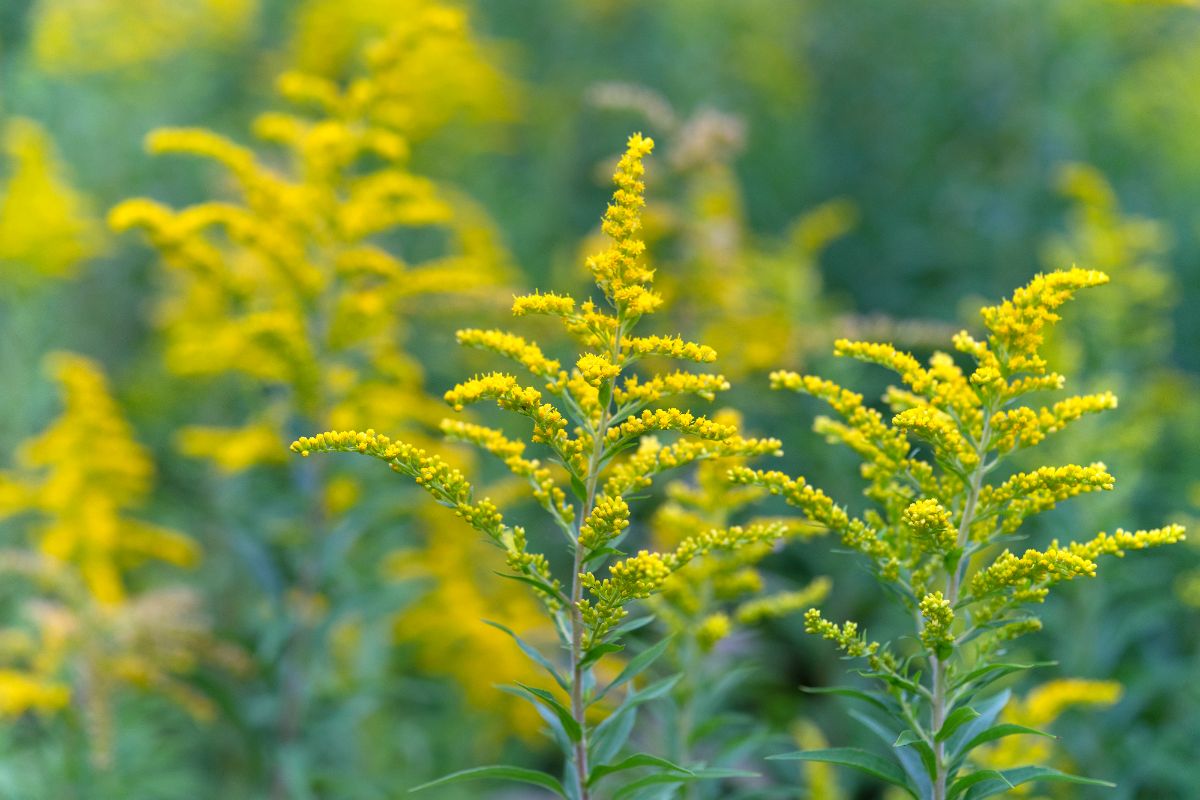
| Plant name: | Goldenrod |
| Color produced: | Yellows, greens |
| Plant parts used: | Flowers |
| Recommended mordants: | Alum, iron |
A common, fall blooming native plant, goldenrod is known for its vibrant yellow flowers that bloom gracefully on slender, arching stems. A favorite pollinator plant, goldenrod is one of the last plants to bloom in autumn, so it’s a perfect choice for fall dye baths.
Compared to yarrow, goldenrod flowers create a richer, warmer yellow color when used as a dye. While alum is the recommended mordant to use with this plant, you can also use iron to create greens too.
6. Yarrow (Achillea millefolium)

| Plant name: | Yarrow |
| Color produced: | Yellows, light tans, greens |
| Plant parts used: | Leaves and stems |
| Recommended mordants: | Alum, iron |
Yarrow is a gorgeous, native perennial flower that blooms spring through fall. Large, flat blossoms are a favorite among pollinators, while the feathery foliage lends itself well to cut flower arrangements. The flowers dry beautifully too for preserved displays.
As a dye plant, yarrow is ideal for creating a range of yellows. The yellow produced by yarrow tends to be on the cooler side of the color range and light tans are also possible. Yarrow can also produce a range of greens when iron mordant is used.
7. Dyer’s chamomile (Anthemis tinctoria)
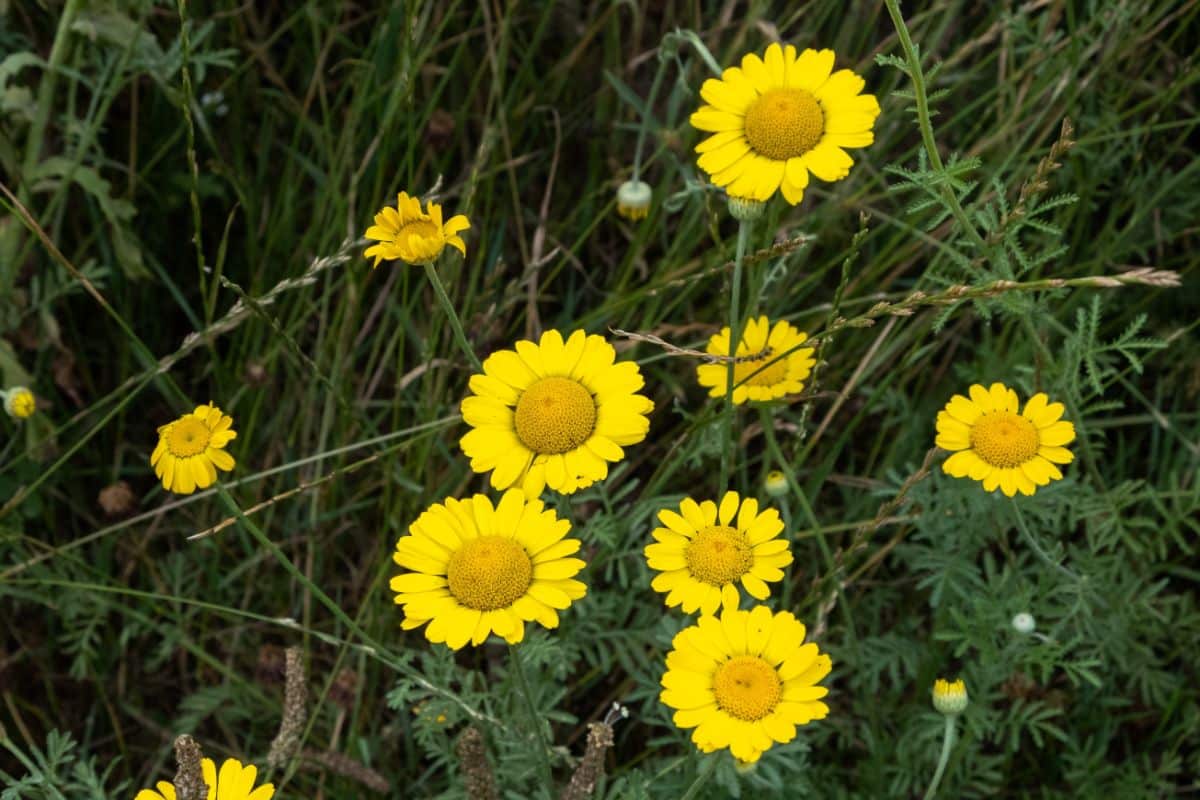
| Plant name: | Dyer’s chamomile |
| Color produced: | Yellows |
| Plant parts used: | Flowers |
| Recommended mordants: | Alum |
Whether planted as a border plant or kept in a container garden, dyer’s chamomile is a sweet flower that will liven up your garden with yellow, daisy-like blooms and fragrant foliage. Growing about 2’ high, these perennial plants generally grow in clumping mounds and prefer well-draining soil.
As a dye plant, dyer’s chamomile reliably produces a warm yellow tone. Flowers can be used fresh or dried and frequent deadheading of your plants will encourage your chamomile to flower more abundantly.
8. Black-eyed Susan (Rudbeckia hirta)
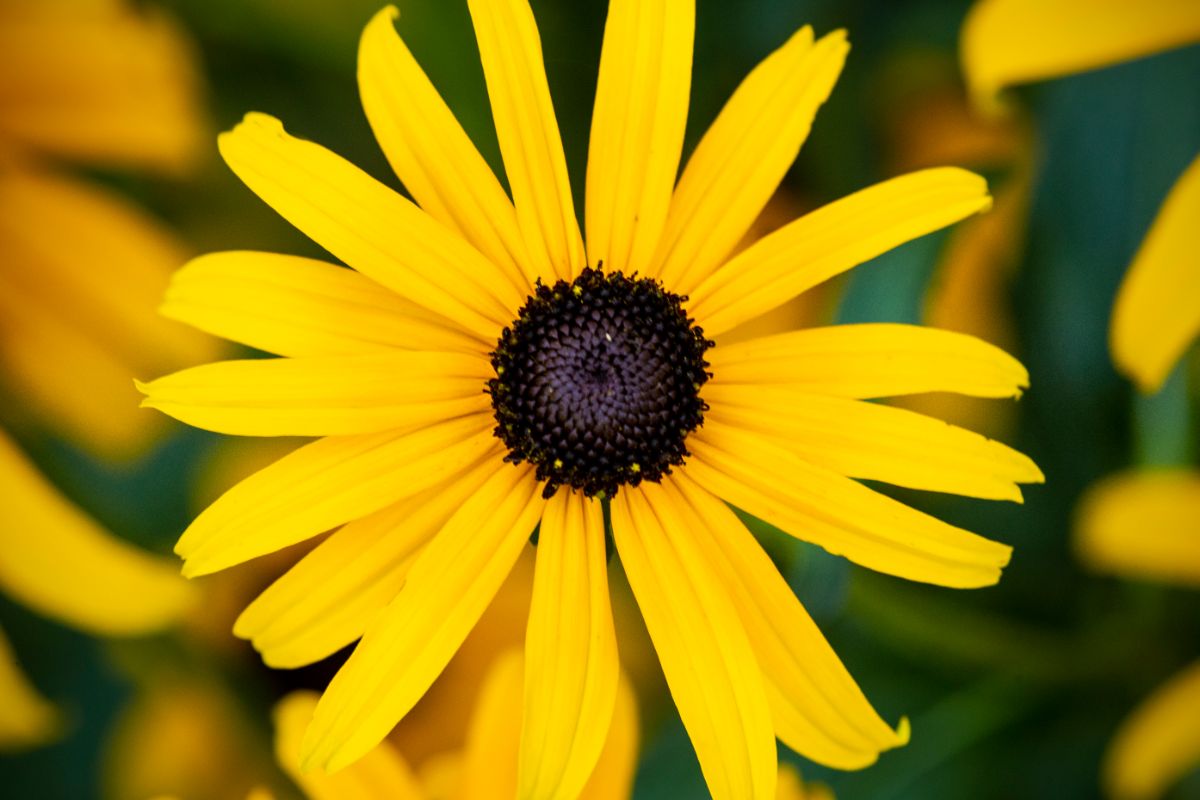
| Plant name: | Black-eyed Susan |
| Color produced: | Gold, oranges, greens |
| Plant parts used: | Flowers, leaves and stems |
| Recommended mordants: | Alum |
Ever-popular black-eyed Susan are known for their warm, golden yellow petals surrounding highly contrasting, chocolatey-brown centers. Blooming from June to October, black-eyed Susan are ideal for pollinator and cut flower gardens. They are also highly versatile plants for home dyeing.
Black-eyed Susan can be used to create golds, oranges and greens, depending on what part of the plant you choose to work with. For golds and oranges, use the plants’ leaves and stems, while the flowers can be broken down to produce a vivid, olive green.
9. Calendula (Calendula officinalis)
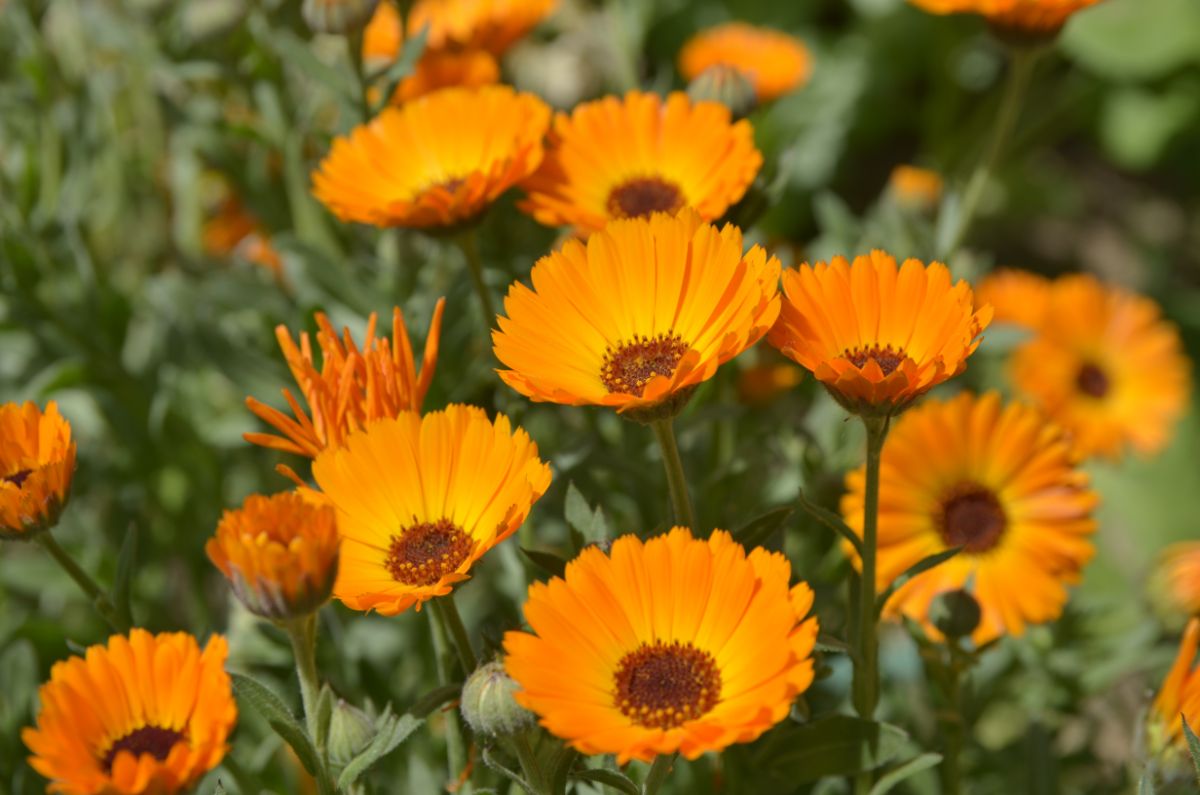
| Plant name: | Calendula |
| Color produced: | Yellows, greens and browns |
| Plant parts used: | Flowers |
| Recommended mordants: | Alum, iron |
A popular plant to grow in medicinal gardens due to its skin soothing properties, calendula flowers are delicate yet cheery with warm golden-yellow petals. Excellent for companion planting around tomatoes and beans, calendula excels at attracting beneficial insects. But this versatile plant has other uses too.
Flowers are edible and make pretty salad toppers. And, if you’re into home dyeing, those same flowers are perfect for coloring fabrics. Colors produced range from yellows to greens and browns and bring a summertime feel to any dye project you create.
10. Bloodroot (Sanguinaria canadensis)
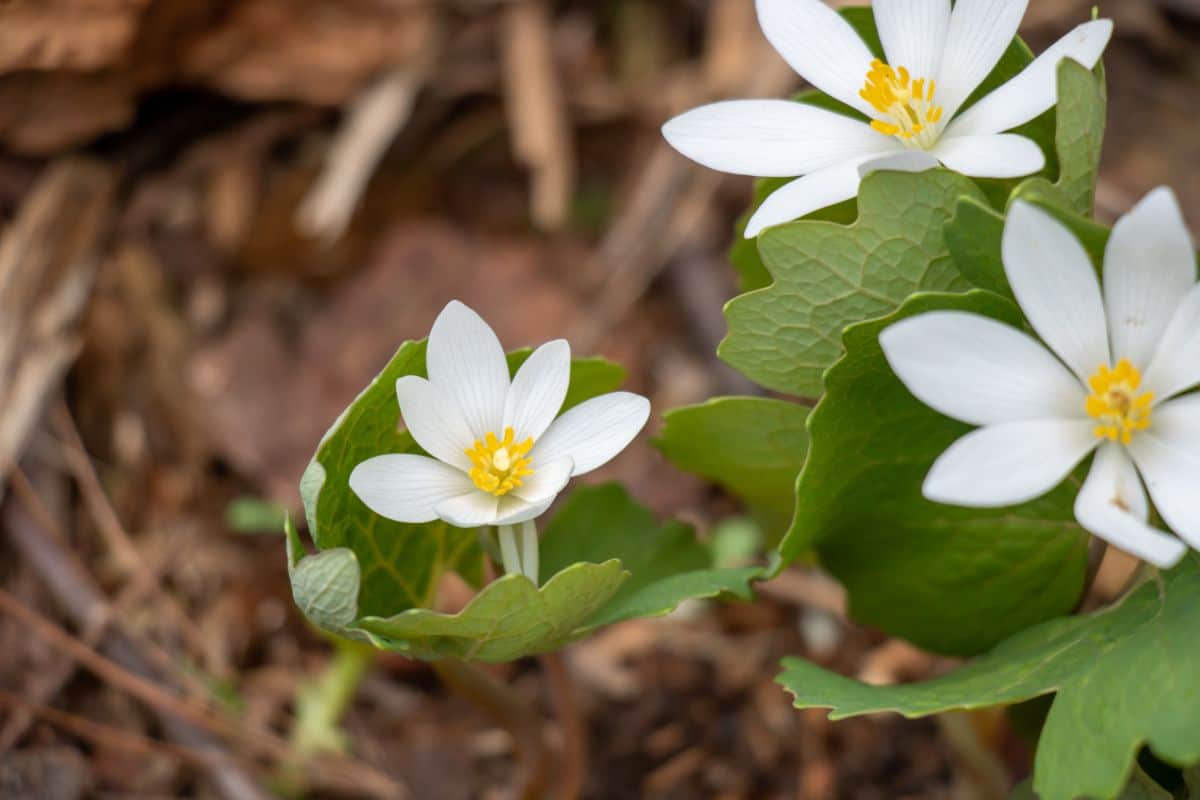
| Plant name: | Bloodroot |
| Color produced: | Pinks, reds, oranges |
| Plant parts used: | Roots |
| Recommended mordants: | None, alum, tin |
Bloodroot is a spring-blooming perennial plant that’s native to North America. A shade loving species, lobed leaves are nicely complemented by small, white flowers that look a bit like miniature waterlilies.
In the dye garden, bloodroot can be used to create a range of colors, depending on your mordant of choice. Without mordant, bloodroot makes a delightful orange color; however, it can make a rust tone with alum and a pinkish-red color with tin.
11. Dyer’s coreopsis (Coreopsis tinctoria)
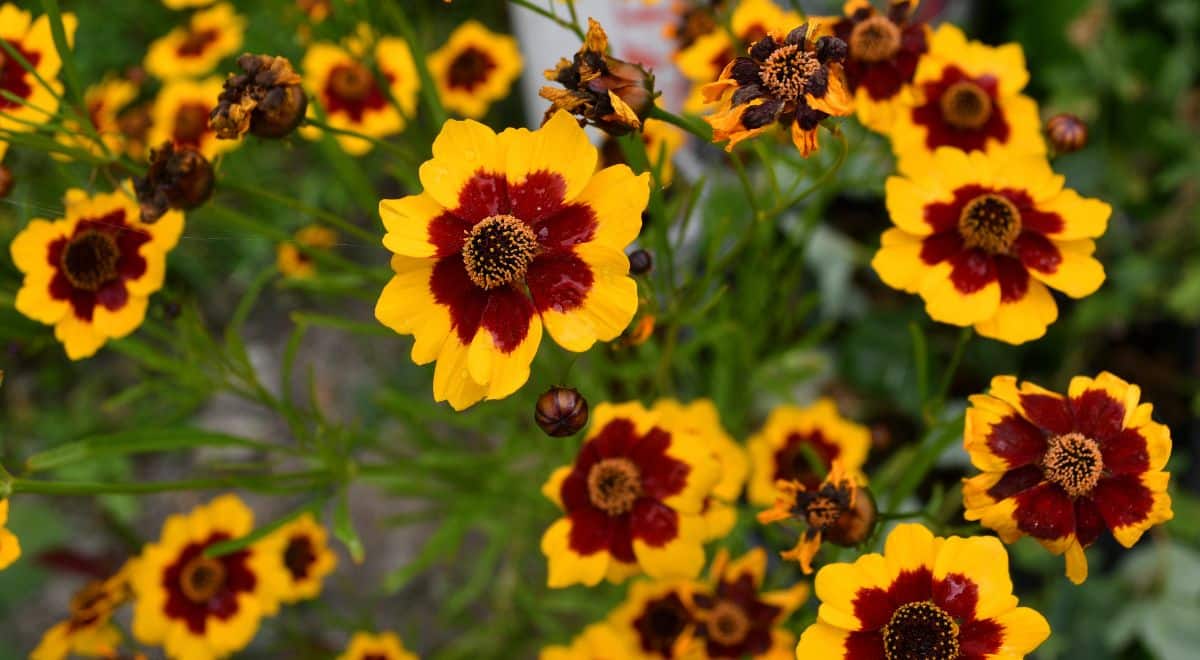
| Plant name: | Dyer’s coreopsis |
| Color produced: | Golds, oranges, reds |
| Plant parts used: | Flowers, whole plant |
| Recommended mordants: | Alum |
A member of the Aster family, dyer’s coreopsis is an easy-going plant that can grow just about anywhere, including in poor soil. Small flowers feature red or two-toned red and gold petals and appear on the ends of long, delicate stems. Bloom time begins in early summer and flowers appear sporadically until the frosts of autumn.
An annual plant, dyer’s coreopsis will need to be planted every year. However, you can count on flowers to produce lots of brightly colored hues, including golds, oranges and rusty reds.
Pink and red plant dyes
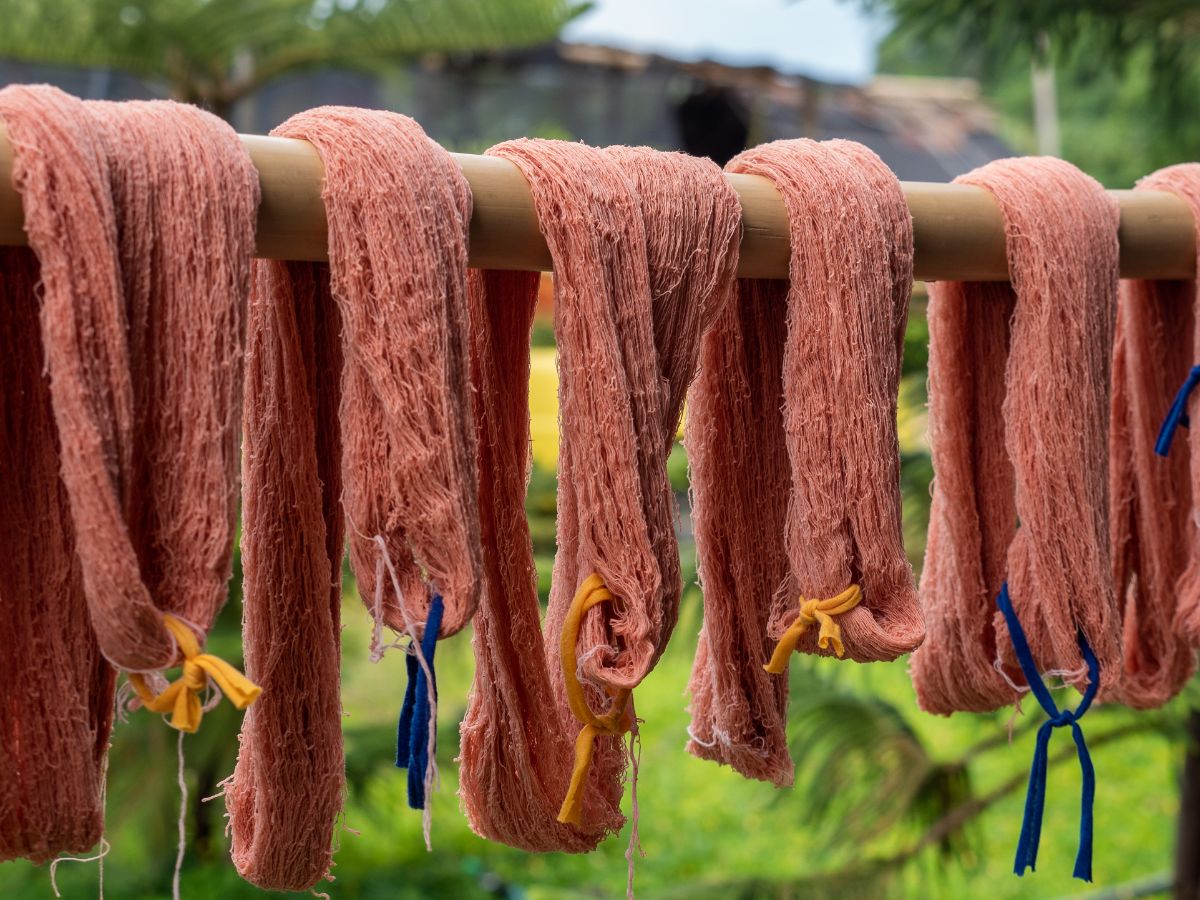
Pinks and reds are eye-catching colors that are super satisfying to work with when home dyeing. Depending on the mordant you choose, you can increase the vividness of your dyes for a totally unique color you just can’t find in storebought fabric.
12. Madder (Rubia tinctorum)
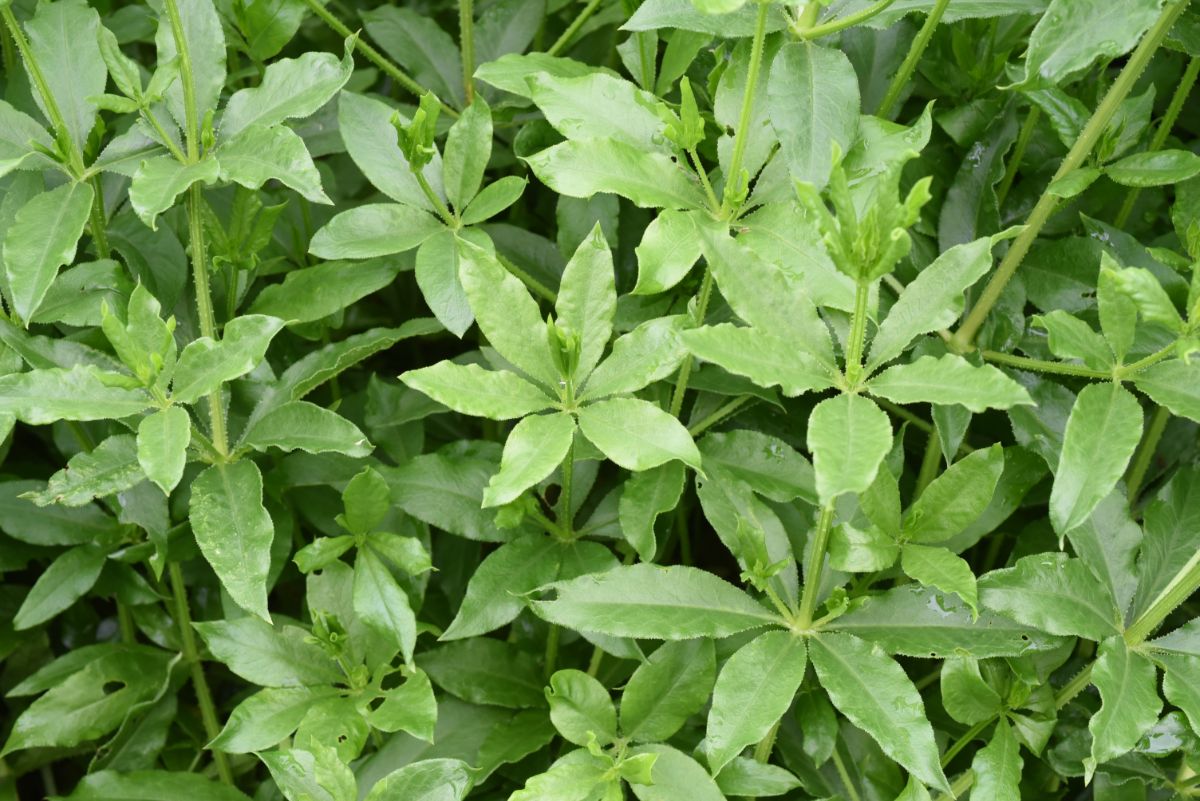
| Plant name: | Madder |
| Color produced: | Red |
| Plant parts used: | Roots |
| Recommended mordants: | Alum, iron |
A classic dye plant, if you’re only going to keep a few plants in your dye garden, madder is a must-have. With whorled foliage and inconspicuous, star-shaped yellow flowers, it may not look like much, but it’s what’s under the soil that counts.
Madder’s roots produce a vivid red color that makes an impressive dye. Used for centuries, there are even traces of madder in King Tut’s tomb! Roots are harvested when they’re about as thick as a pencil, which can take about 2 to 5 years.
13. Hollyhock (Alcea rosea)
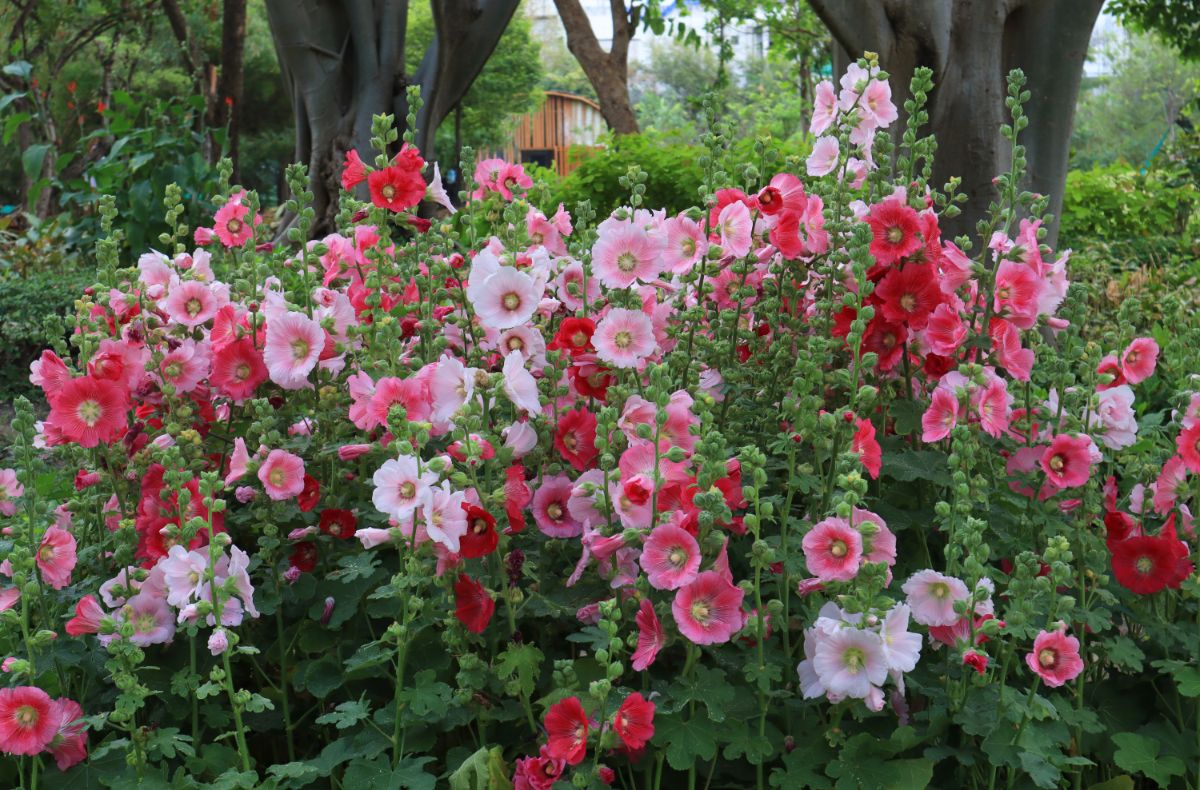
| Plant name: | Hollyhock |
| Color produced: | Golds, yellows, browns, purples, pinks and reds |
| Plant parts used: | Flowers |
| Recommended mordants: | Alum |
Hollyhocks are popular perennial plants that are members of the Mallow family. Growing quite tall, hollyhocks are mostly prized for their gorgeous and colorful flowers that bloom in summer and come in lots of different colors, including yellows, pinks and dark purples.
Hollyhock flowers are ideal for cut flower displays, but they are also the part of the plant that’s used for dyeing. Flower color determines the tone of your dye, with light-colored flowers producing yellows, golds and browns and dark-colored flowers creating pinks, purples and reds. If you want lots of color in your dye garden, try planting different hollyhocks for lots of color options.
14. Beets (Beta vulgaris)
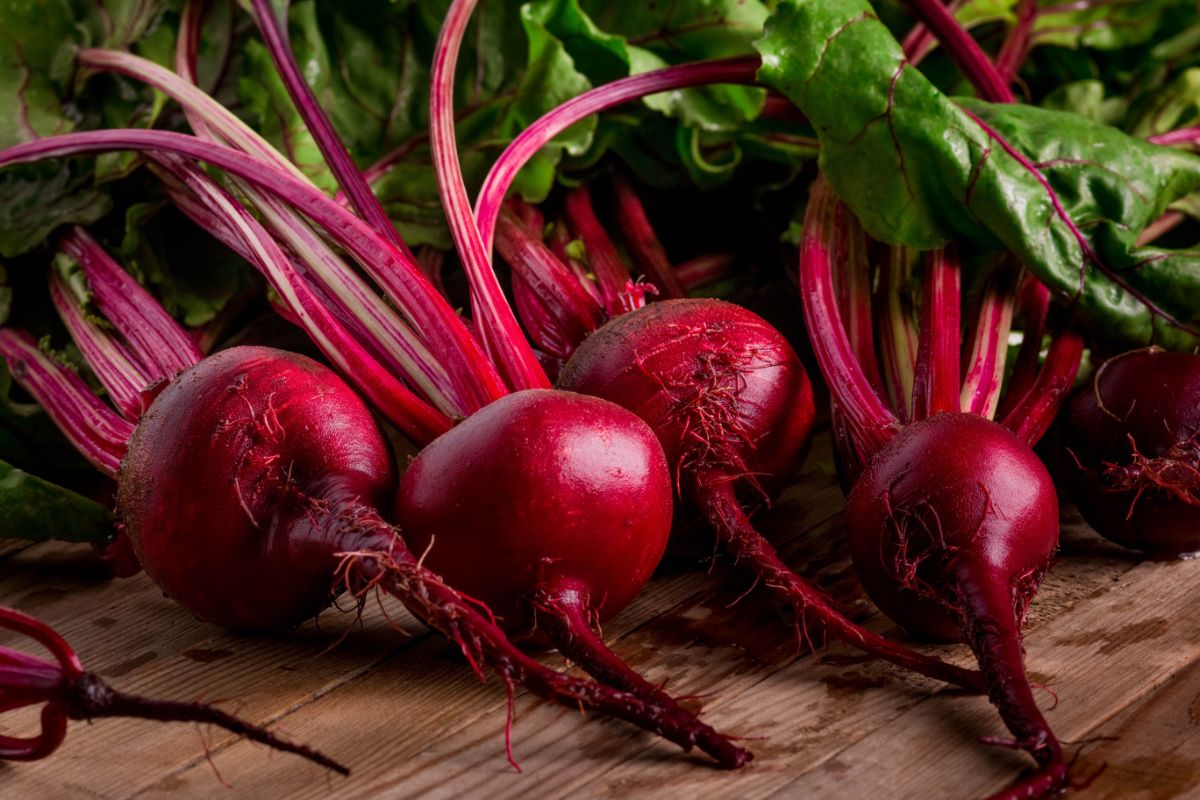
| Plant name: | Beets |
| Color produced: | Pinks and reds |
| Plant parts used: | Roots |
| Recommended mordants: | Alum |
Beets are easy to grow in vegetable gardens and do particularly well in spring and fall beds when cooler temperatures will allow the roots to fill out more. Beet greens are tasty additions to soups and sautés and work well in fresh salads too. However, if you’ve ever cooked with beets, you know they can stain pretty much anything… which makes them a perfect pick for dyeing.
For pale pinks, chopped beets can be simmered in water for several hours with an alum mordant. Get richer colors by utilizing the leftover juice from pickled beets and mixing in some grated beet root for an extra color punch. Just be sure to keep temperatures low as you work, so as not to denature the dye colors.
15. Pokeberry (Phytolacca spp.)
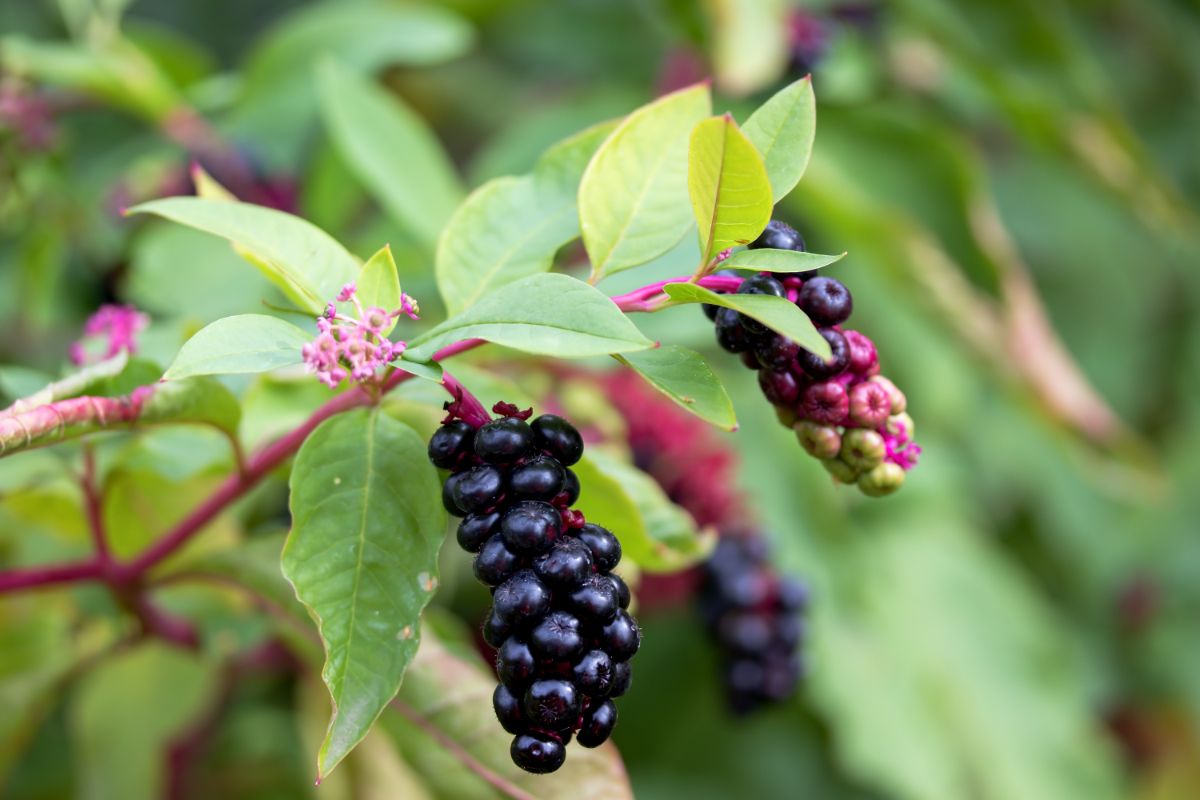
| Plant name: | Pokeberry |
| Color produced: | Pinks, reds, oranges |
| Plant parts used: | Berries |
| Recommended mordants: | Vinegar |
Pokeberry is a common weed, so you may not want to keep it in your garden, although it may sprout up on its own. That said, pokeberry is easy to find when foraging for wild dyes and is simple to recognize thanks to its distinct clusters of round, dark berries.
As a dye, pokeberry is easy to work with and only requires vinegar as a fixative. It can also produce a good range of colors, including bright pinks and fuchsia, oranges and reds.
16. Dyer’s woodruff (Asperula tinctoria)
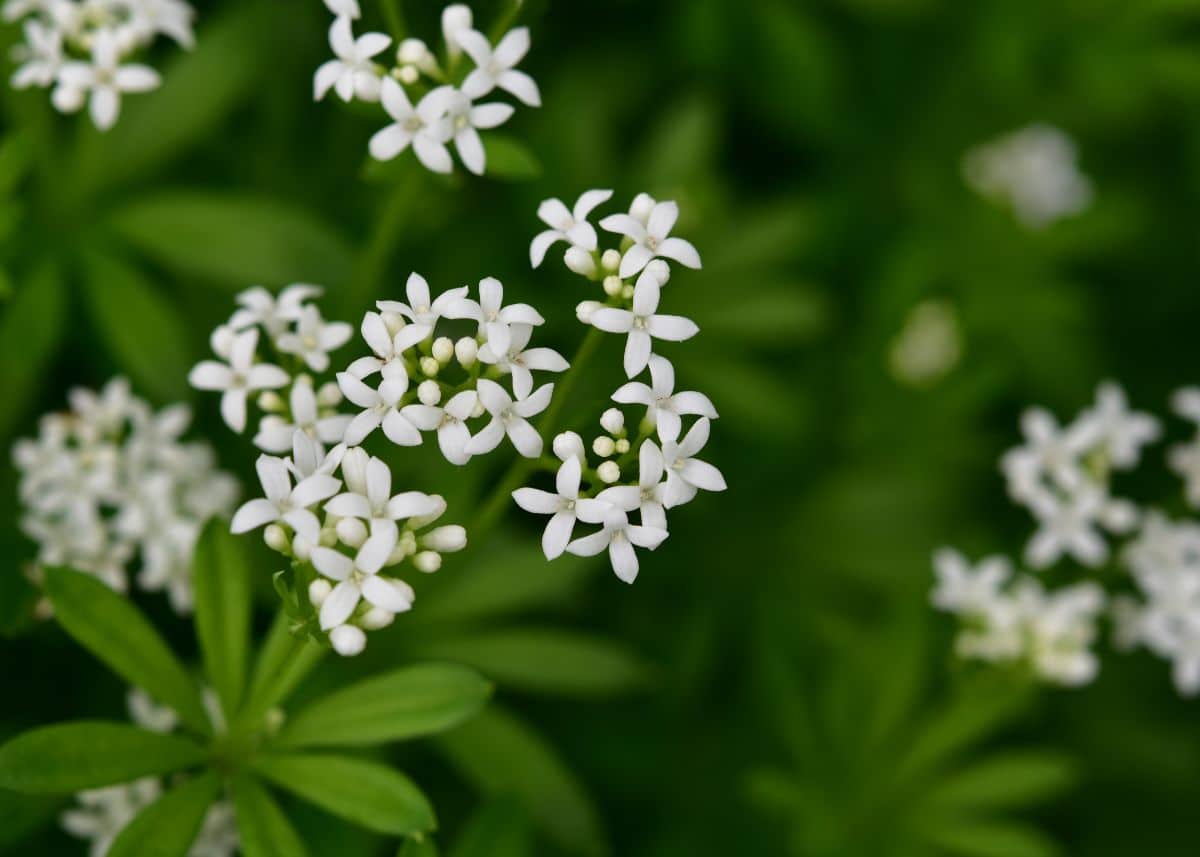
| Plant name: | Dyer’s woodruff |
| Color produced: | Reds |
| Plant parts used: | Roots |
| Recommended mordants: | Alum |
An airy plant with whorled leaves, dyer’s woodruff is a close relative of sweet woodruff, a common ingredient in homemade potpourris. Dyer’s woodruff has delicate, white flowers that bloom in early summer and provide nectar and pollen for many pollinator insects.
A red dye is produced from the roots of this plant. However, as the plant is slow growing, it may take about 3 to 5 years until the roots are mature enough to harvest.
Green plant dyes
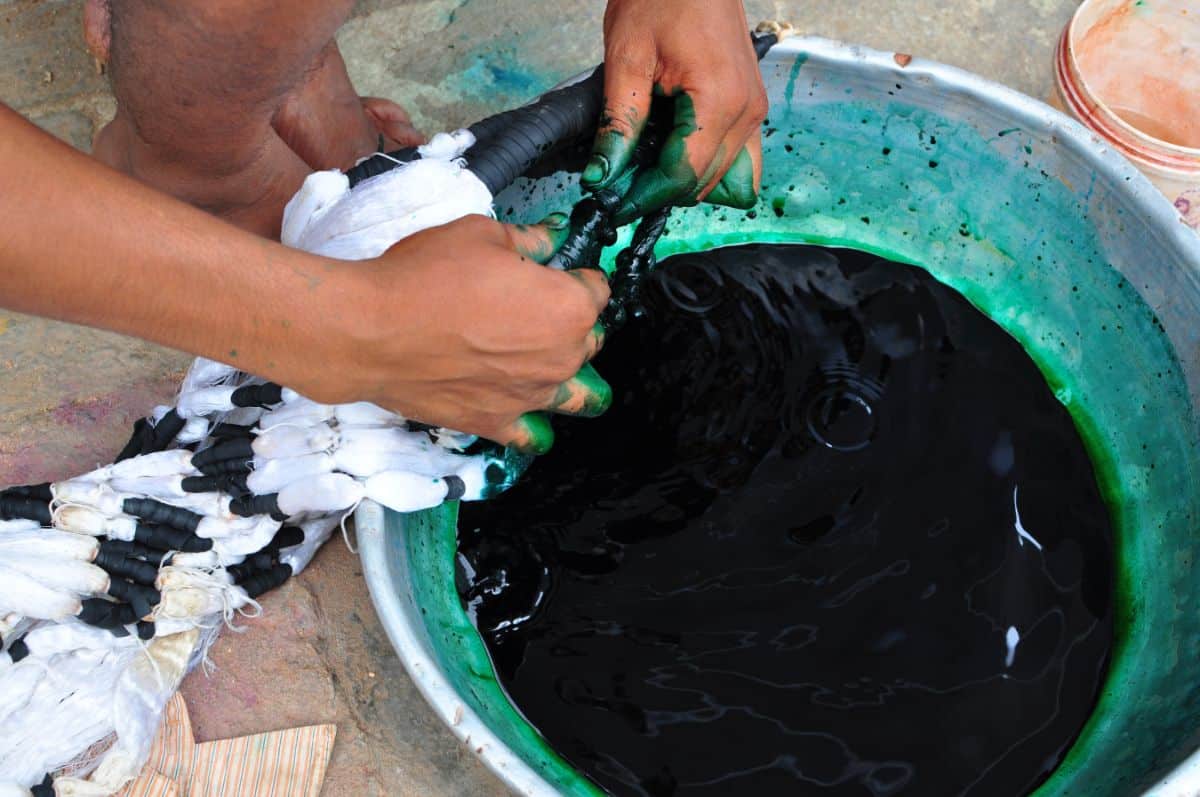
Since most plants contain lots of chlorophyll, many different species can be used to create green dyes. However, some plants produce richer dyes than others, while some reliably create specific green shades, such as emerald or chartreuse. Below are some of our top choices for plants to try for the best green dyes.
17. Foxglove (Digitalis purpurea)
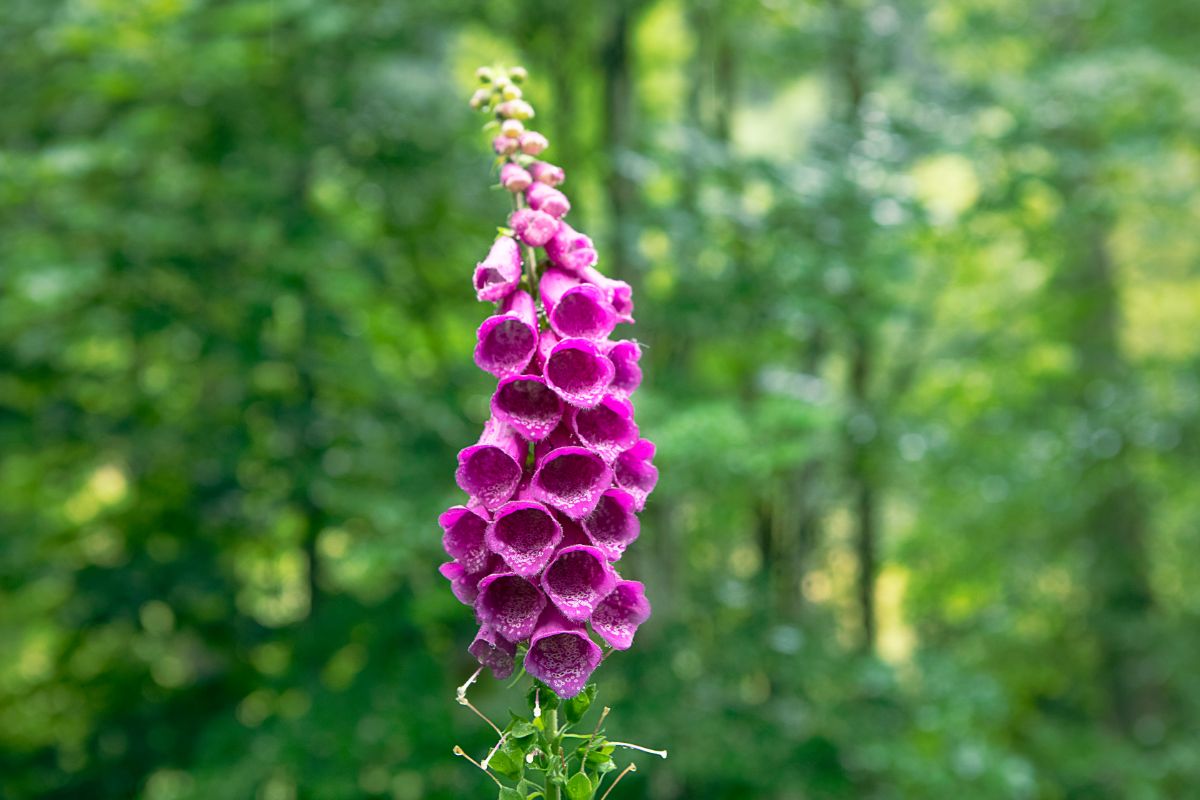
| Plant name: | Foxglove |
| Color produced: | Greens |
| Plant parts used: | Flowers and leaves |
| Recommended mordants: | Alum |
Foxgloves are shade-loving native plants with a very distinct look. Colorful, tubular flowers come in a range of colors that bloom in spires atop tall stems for lots of vertical interest in garden beds. Thanks to their unique look, foxglove is perfect for fairy gardens, but it makes a wonderful dye plant too.
Leaves and flowers can be used to produce different shades of green. Just keep in mind that this plant is toxic, so it’s best avoided if you have small children or curious pets in your garden space.
18. Dandelion (Taraxacum officinale)
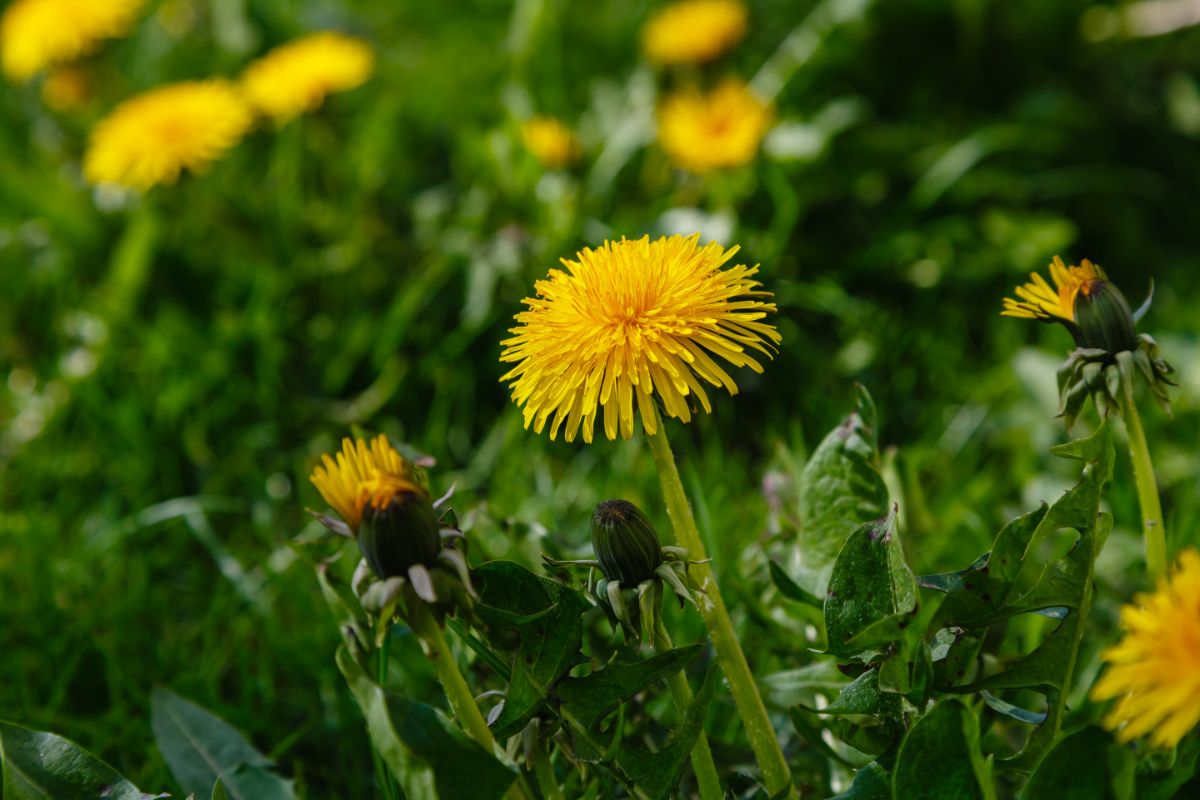
| Plant name: | Dandelion |
| Color produced: | Yellows, greens and browns |
| Plant parts used: | Flowers, leaves and roots |
| Recommended mordants: | Alum, copper, vinegar and salt, tin |
Common dandelions were once spurned as nuisance weeds; however, many gardeners are more likely to tolerate these plants today, thanks to their sheer utility. Completely edible and full of antioxidants, dandelion roots can be roasted as a coffee substitute, the leaves eaten as cooked greens and the flowers used as salad toppers.
In the dye garden, dandelions are similarly flexible plants. Depending on the mordants you use and what parts of the dandelion plant you’re working with, you can create yellow, green and brown tones.
19. Larkspur (Delphinium spp.)
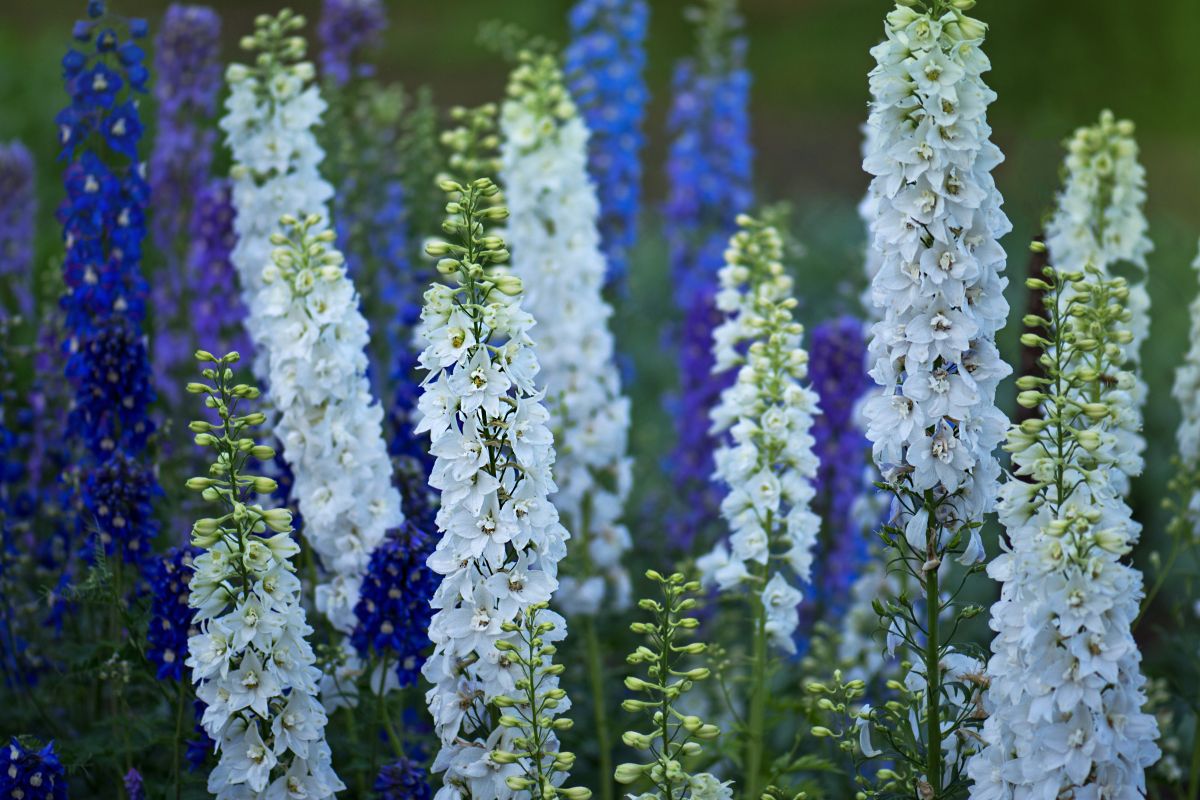
| Plant name: | Larkspur |
| Color produced: | Green |
| Plant parts used: | Flowers |
| Recommended mordants: | Alum |
Larkspur flowers are hard to miss with their stunning indigo hue, although they come in pinks and purples too. Flowers appear atop long spires and bloom in autumn. A must-have in cottage gardens, larkspurs are sure to attract bees and other pollinators to your space.
Although you may expect larkspurs to create a blue dye, they’re known for producing a green color instead. Their interesting forms also make them especially well-suited for flower printing techniques.
20. Spinach (Spinacea oleracea)
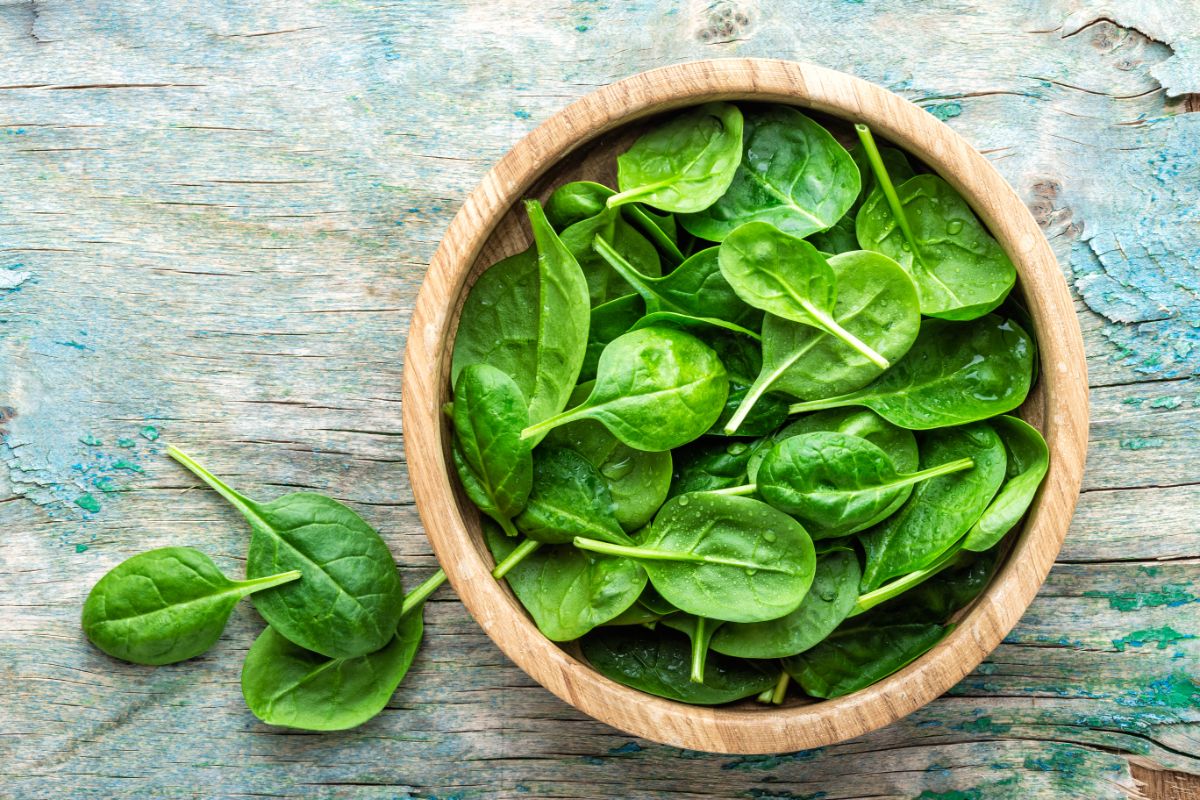
| Plant name: | Spinach |
| Color produced: | Greens |
| Plant parts used: | Leaves |
| Recommended mordants: | Alum, tin, iron |
A cool weather vegetable, spinach is a common plant to keep in spring and fall gardens. Prone to bolting when temperatures rise, spinach is otherwise quite easy to maintain and is frequently eaten in salads, blended into smoothies or cooked up into pasta dishes, casseroles and sautés.
As a dye plant, spinach leaves create a bright, chartreuse color that is very attractive. This color can be deepened further with an addition of iron, or when infused with other chlorophyll-rich plants like grass clippings or kale.
Brown plant dyes
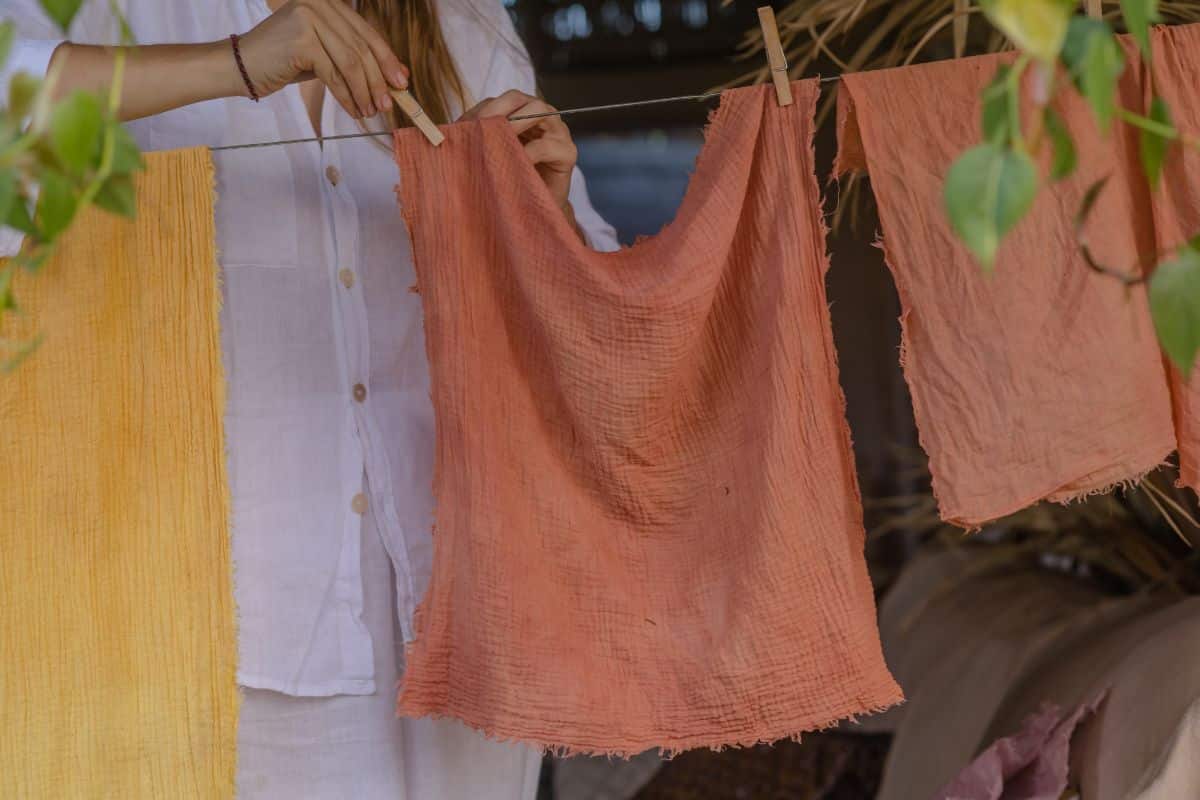
Deep, earthy browns, tans and beiges are staples in wardrobes and add warmth when sewn into throw pillows and other decorative accents. If you’re looking to create your own brown dyes, try out these easy going plants.
21. Chicory (Cichorium intybus)
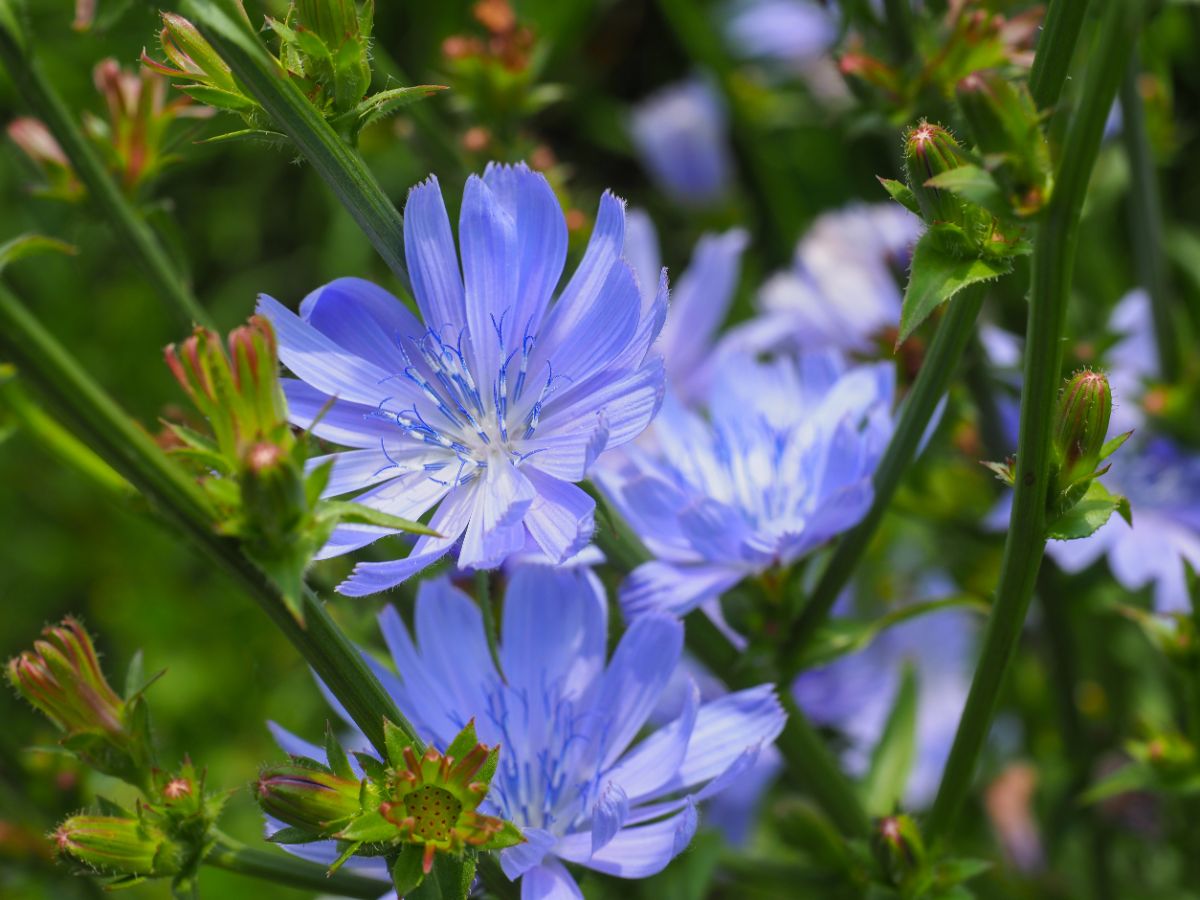
| Plant name: | Chicory |
| Color produced: | Browns |
| Plant parts used: | Roots |
| Recommended mordants: | Alum, iron |
Chicory is a common sight along roadsides and woodland paths, where its bright blue, daisy-like flowers are hard to miss. Roots of this plant are also commonly used as a coffee substitute after drying.
But the utility of chicory goes even further. Roots can also be simmered with an alum mordant for about an hour. The dye produced from this process is ideal for animal-based fibers and the color can be deepened with the addition of a bit of iron.
22. Zinnia (Zinnia elegans)
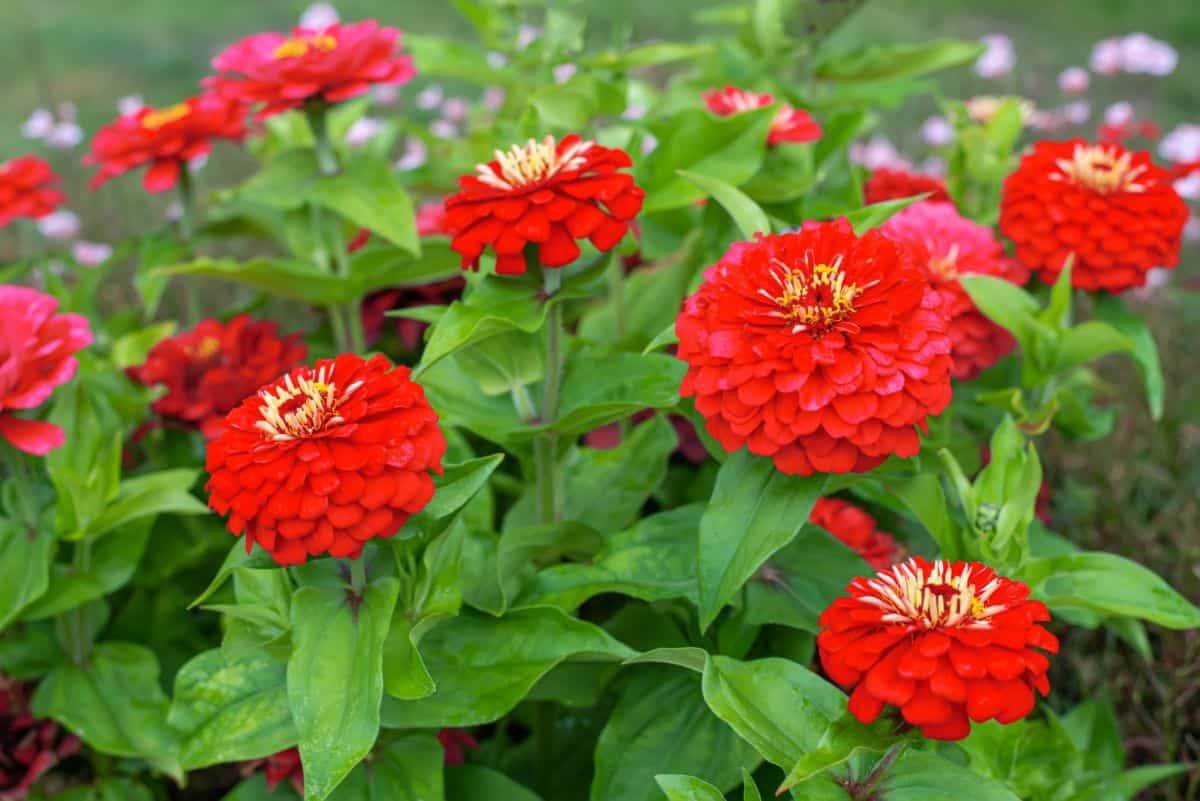
| Plant name: | Zinnia |
| Color produced: | Tans and beige |
| Plant parts used: | Flowers |
| Recommended mordants: | Alum |
Vibrant zinnia flowers bloom all summer long and can last until the hard frosts of autumn. Flowers are ball-shaped with petals in varying colors, including oranges, pinks and yellows. A popular plant for bees and other pollinators, zinnias can also be used as a companion plant in vegetable gardens to attract beneficial insects.
As a dye plant, zinnia flowers are known to produce tan and beige colors. Although these tones are much more muted than zinnias’ summertime petals, they are pretty tones, nonetheless.
23. Red onions (Allium cepa)
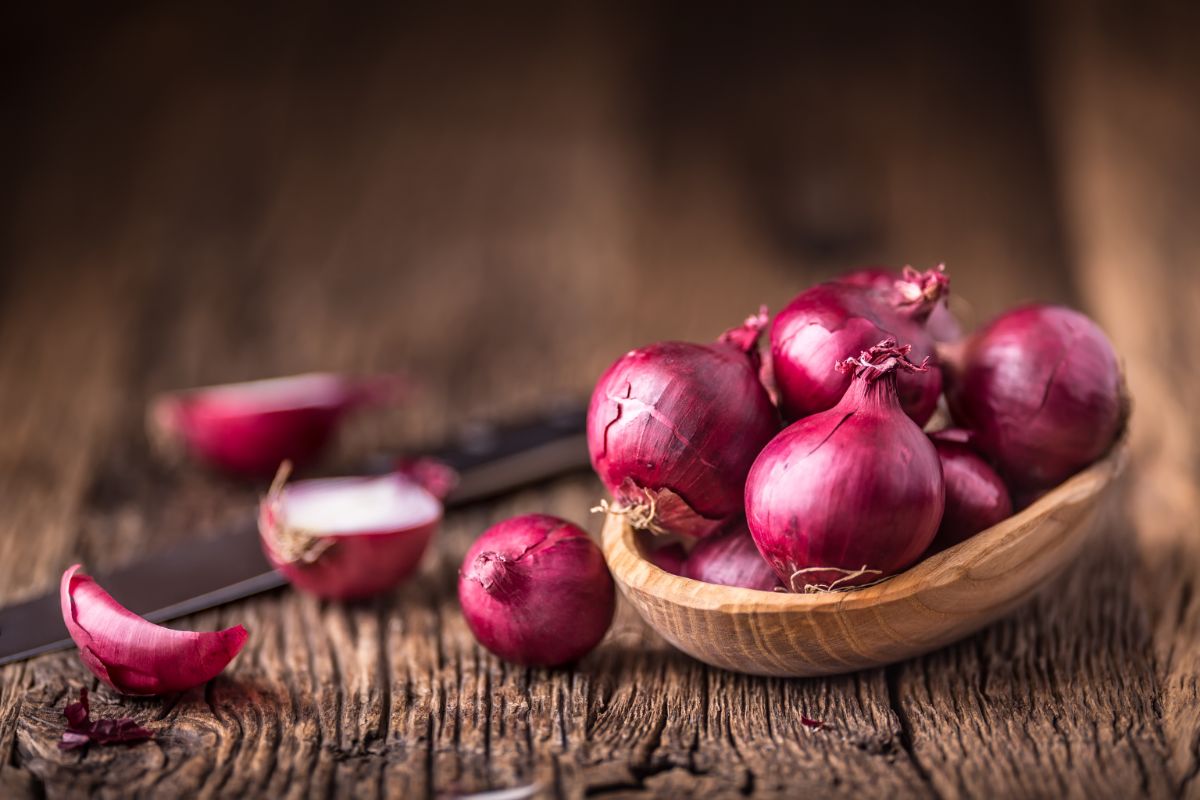
| Plant name: | Red onions |
| Color produced: | Browns and tans |
| Plant parts used: | Skins |
| Recommended mordants: | None |
One of the easiest natural dyes to source, try collecting onion skins this canning season as you process your onions for pickles and relishes. To keep your onion skins fresh longer, freeze them in a Ziploc bag until you’re ready to get your dye vat going.
While the skin from any color of onion can work as a homemade dye, the shades produced from red onions tend to be the most colorful. Red onion skin dye can produce a range of earthy hues and doesn’t require the use of a mordant during the dyeing process.
Purple plant dyes
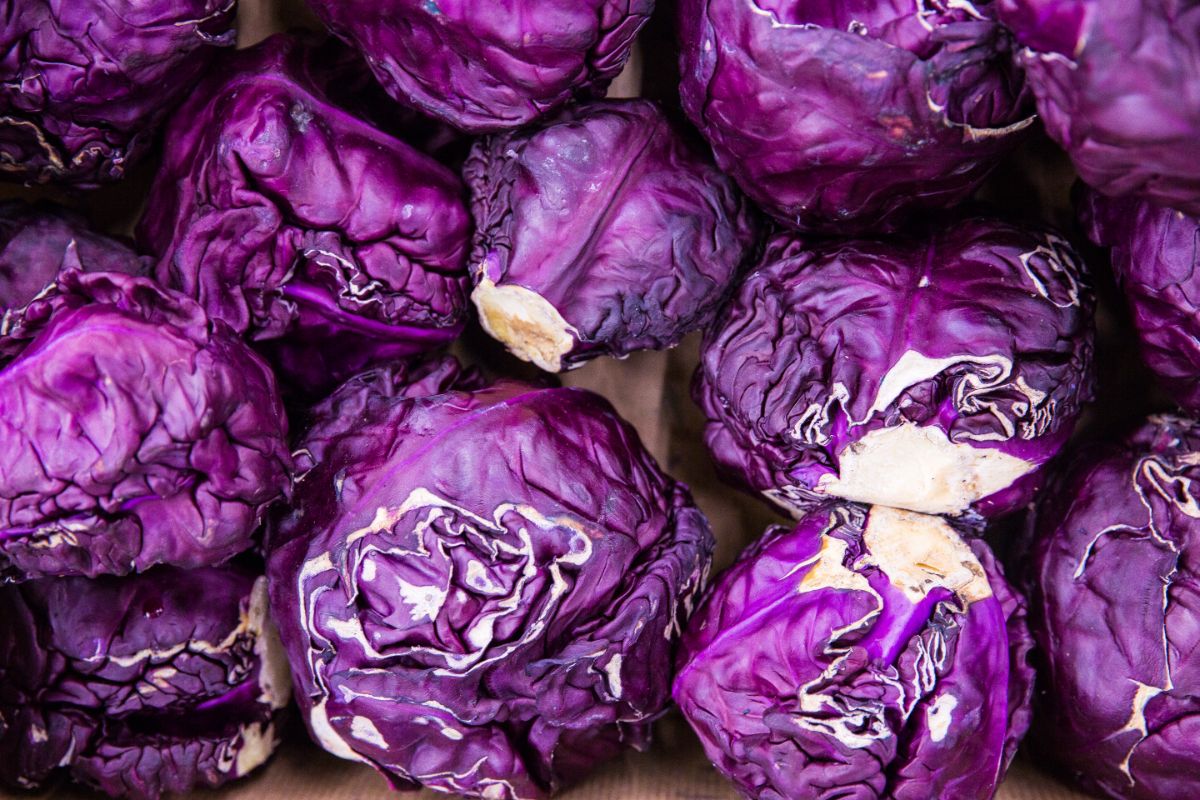
Once considered to be the color of royalty, historically purple dye has been the most difficult color to produce. While snail shells were often used to create purple colors, there are a few plants to try for lavender and violet tones.
24. Red cabbage (Brassica oleracea)
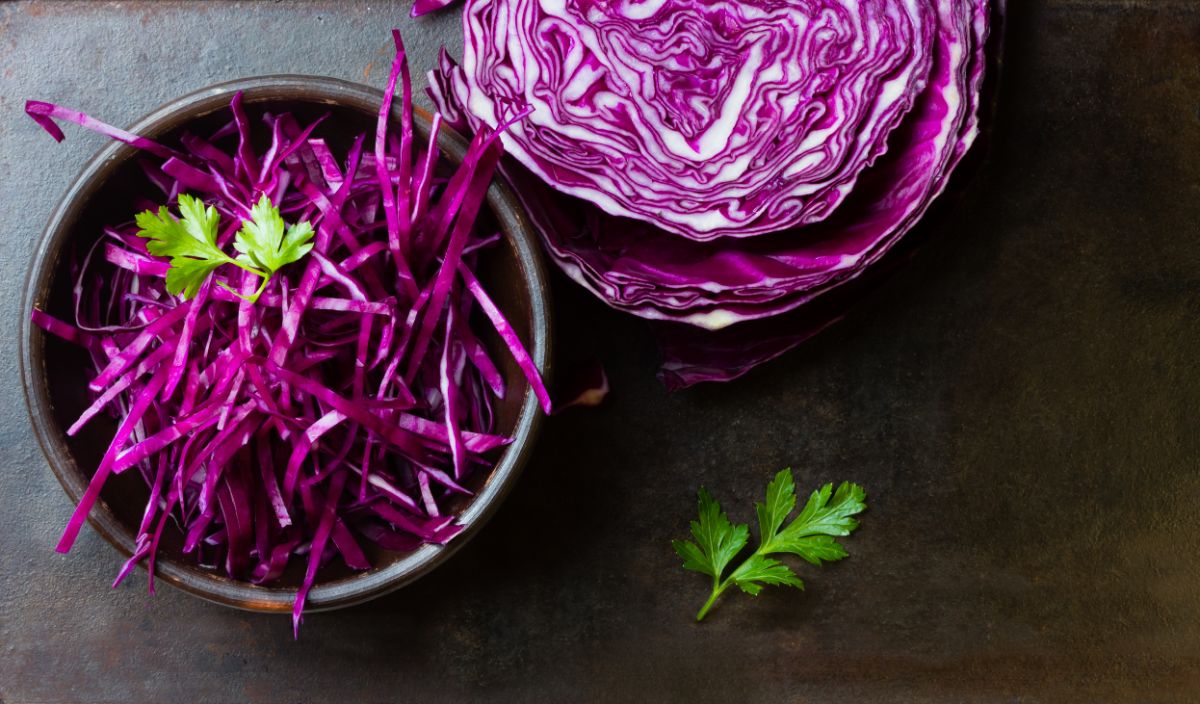
| Plant name: | Red cabbage |
| Color produced: | Purples and blues |
| Plant parts used: | Leaves |
| Recommended mordants: | None, baking soda, vinegar |
Another versatile vegetable, red cabbage is perfect for homemade sauerkraut, coleslaw, stuffed cabbage rolls and many other recipes. But it is also a super flexible dye plant too!
Depending on what mordant you use, you can create many different colors with red cabbage as pH levels dramatically impact the dye colors from this plant. Without mordant, red cabbage leaves will produce a purple dye. With added baking soda (alkaline), you’ll form a robin’s egg blue color, while vinegar can be used for a magenta tone.
25. Alkanet (Anchusa offinicinalis)
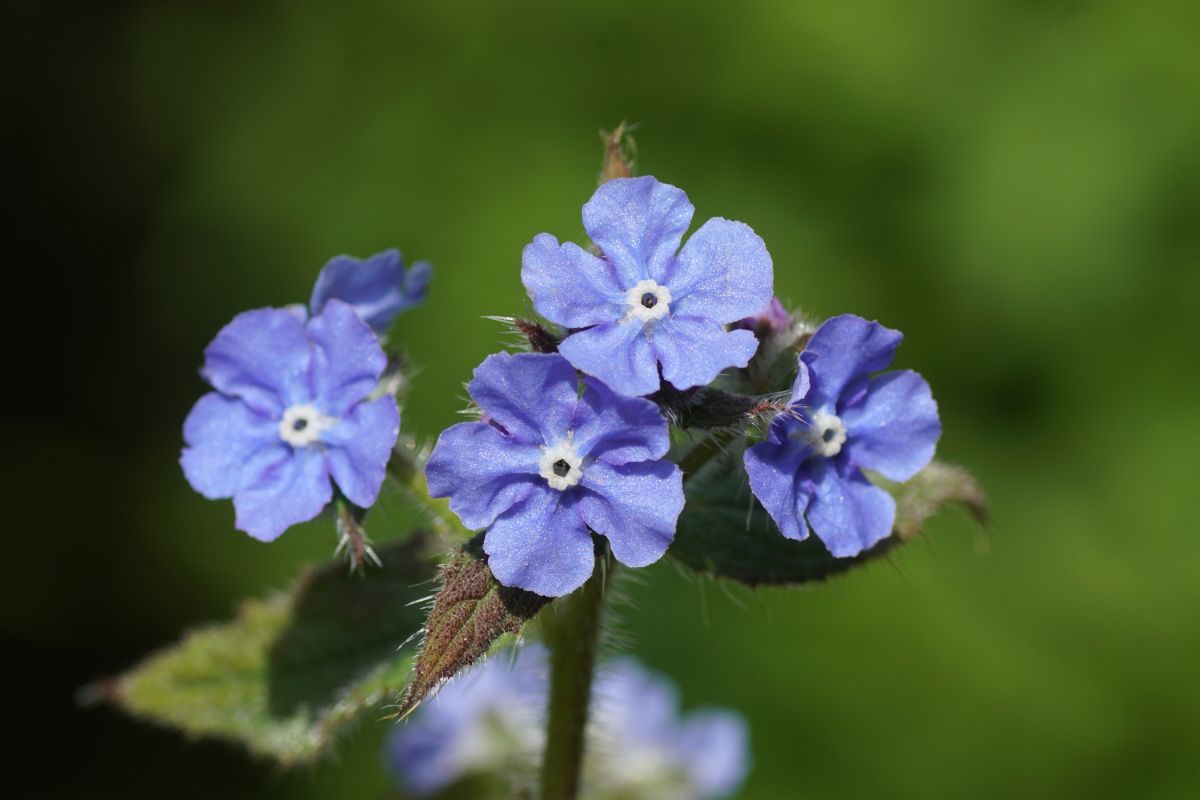
| Plant name: | Alkanet |
| Color produced: | Purples |
| Plant parts used: | Roots |
| Recommended mordants: | None |
A relative of borage, alkanet is a traditional dye plant, but it has been used to create lipsticks and rouge and was once considered to be a valuable medicinal plant too. Pretty, purplish-blue flowers bloom in late spring to early summer for lots of garden color. While this plant grows best in full sun, it can adapt to afternoon shade as well.
A biennial plant, you’ll need to resow alkanet in your dye garden every two years, or more frequently if you like the flowers. For dyeing purposes, alkanet’s roots are the plant part of choice and produce a range of purples, even without mordant.
Frequently asked questions
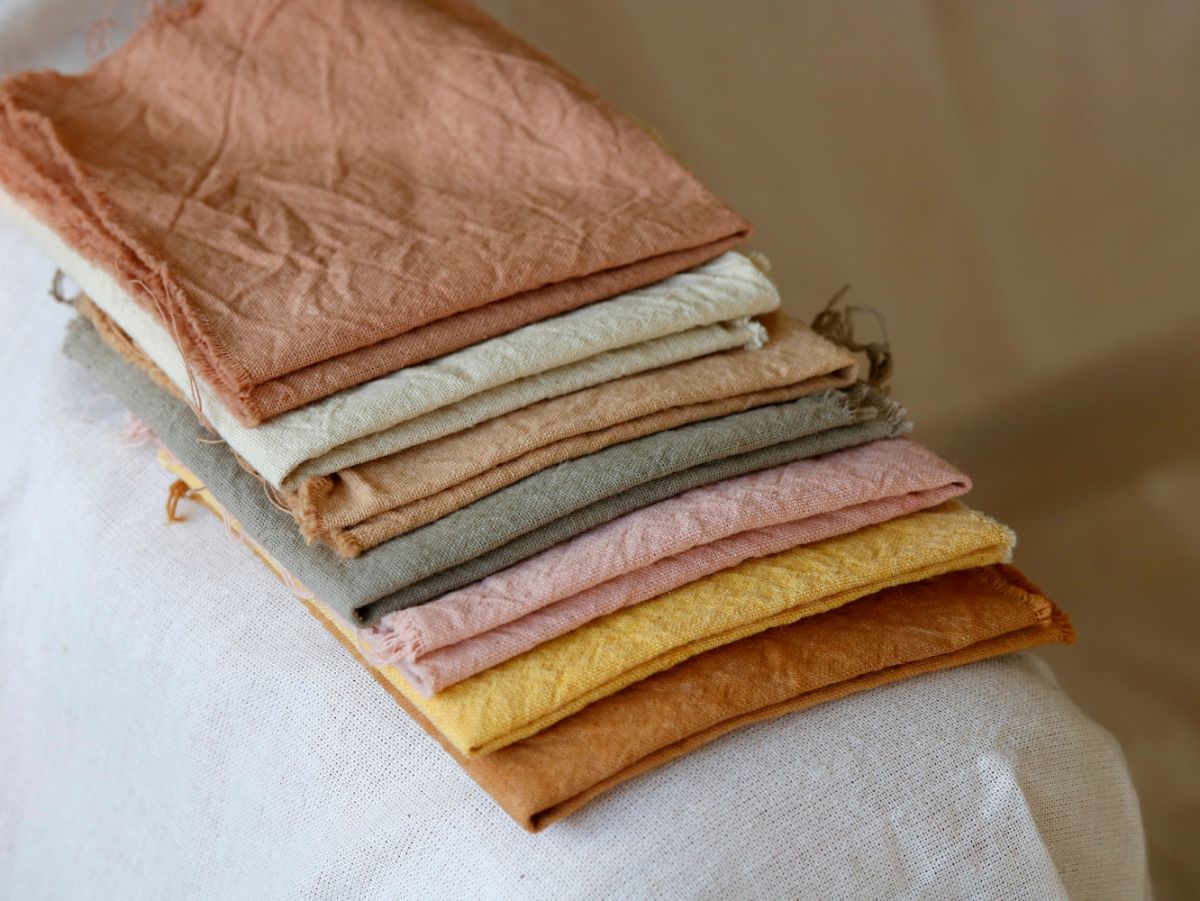
Different plants and textiles require different mordants to fix dye colors. Some of the most common mordants to use include alum, iron, copper sulfate, tin, vinegar, chrome, ammonia, baking soda and cream of tartar. Some mordants are safer than others and some mordant types should not be mixed together.
Natural dyes work much better on natural fabrics than synthetic ones. For best results, try eco-friendly textiles like cotton, wool, linen and silk.
Synthetic fabric dyes can have devastating effects on the environment. Natural dyes, on the other hand, are generally much more eco-friendly and potentially completely non-toxic, depending on your mordant of choice.
Many different plants can be used for home dyeing, so try experimenting with different species to see what colors you get. Some of the best plants for home dyeing include woad, Japanese indigo and madder.
Summary
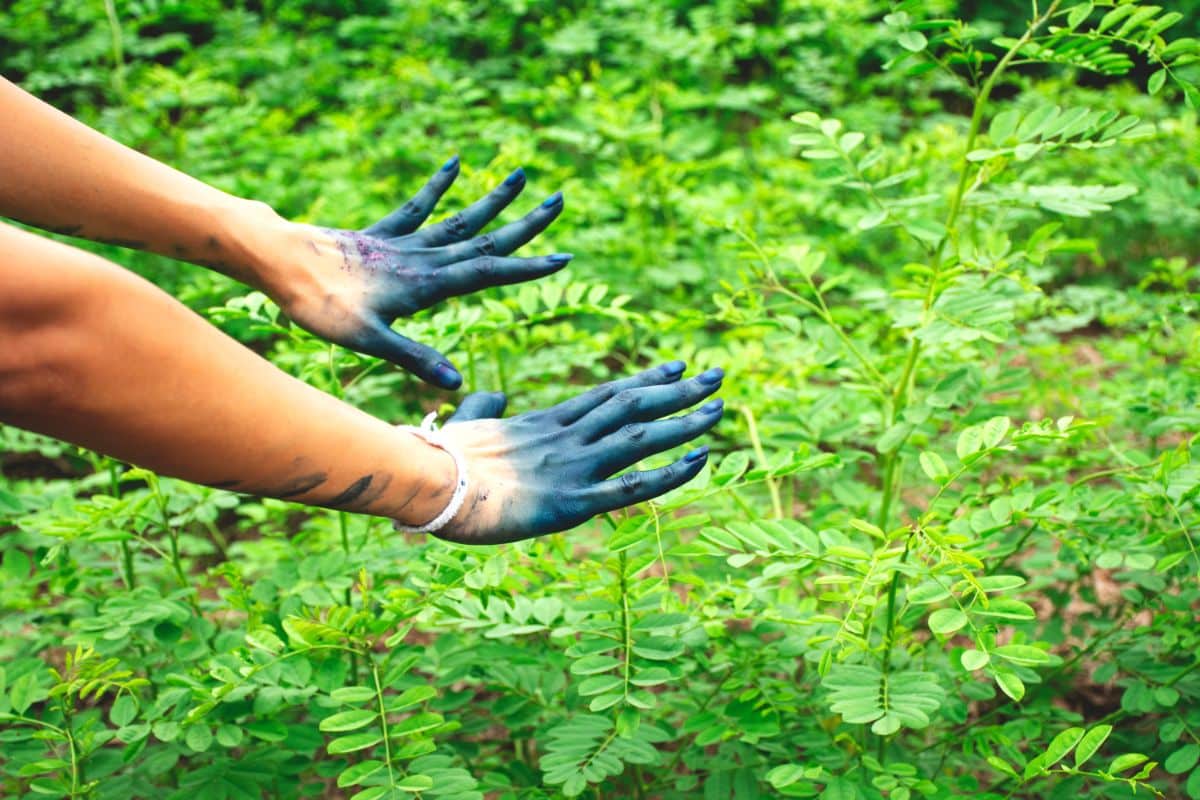
If you’re looking for a new craft to try, dyeing fabric at home with natural dyes can be a fun experiment that can teach you a lot. By trying out different plants, mordants and textiles types, you can create a whole range of different fabric colors for home décor or DIY fashion.
Once you start playing around with natural dyes, you may also be tempted to try out different dyeing techniques, like Shibori or flower printing. Don’t be afraid to get creative and think outside the box with your projects. You’ll be surprised how many gorgeous colors you can create with just a handful of plant leaves or petals.
If you liked this article, check out our piece on the top perennials to try in your backyard for even more garden color!

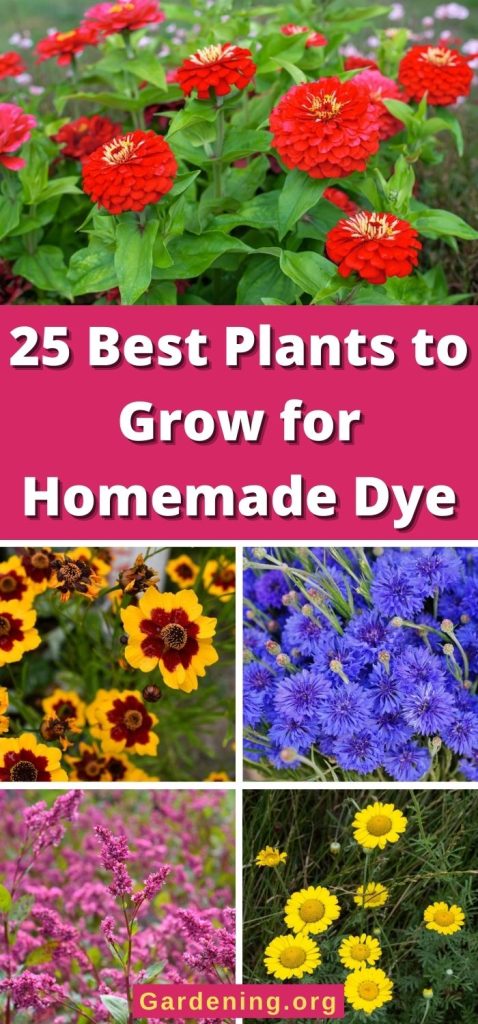
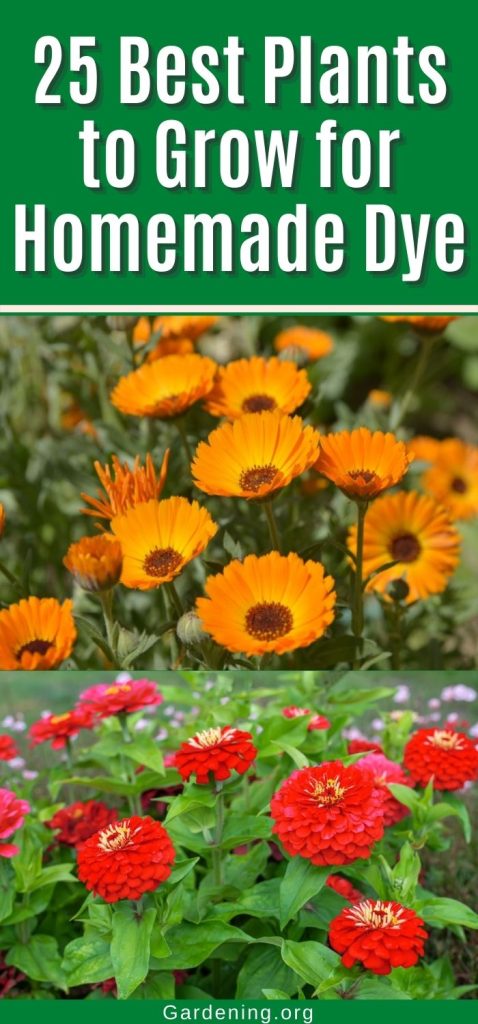
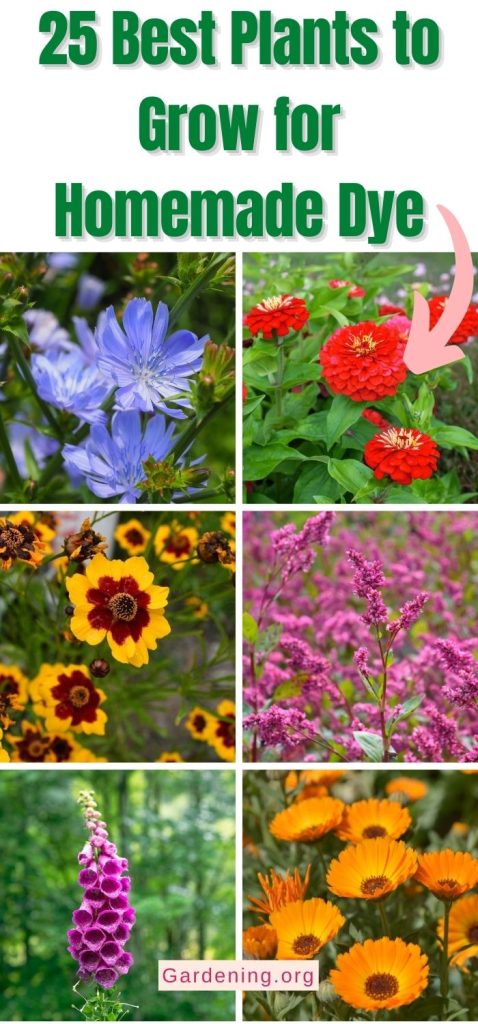
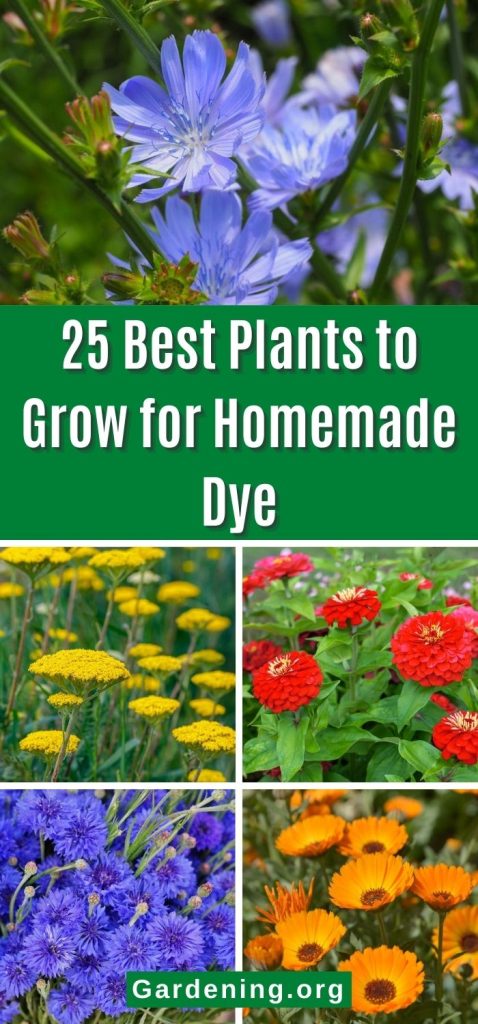




Heather
What a fabulous article. So inspiring. I want to just go try it all. My medium is wool so let’s see how we go. Thankyou again for the inspiration